

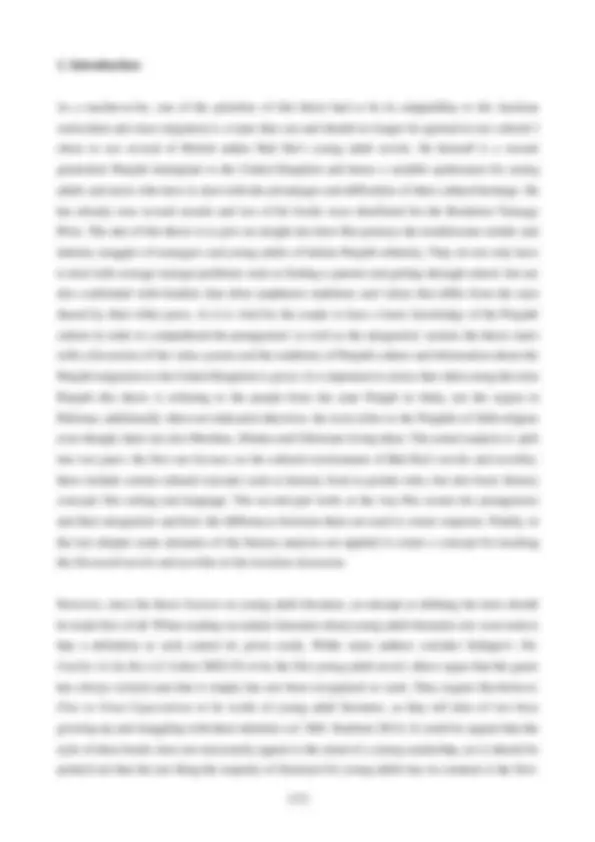

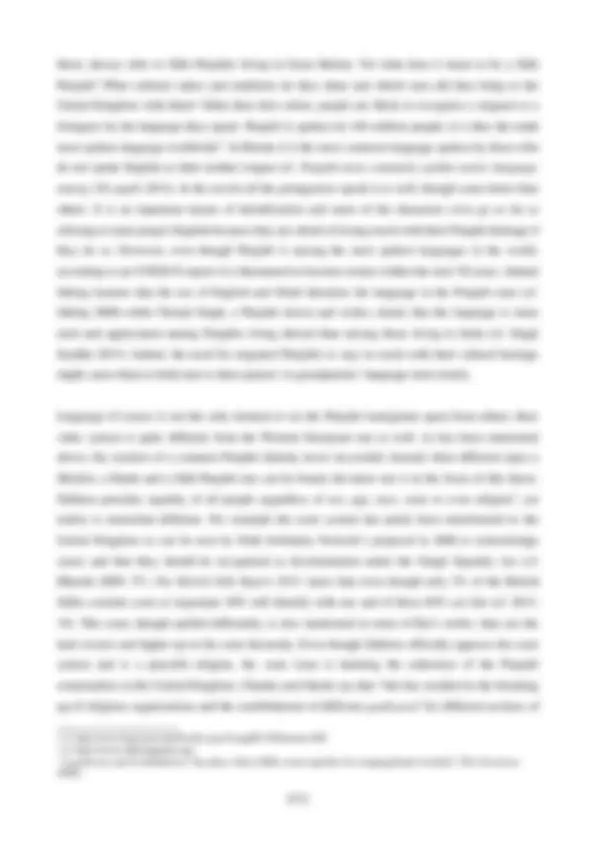
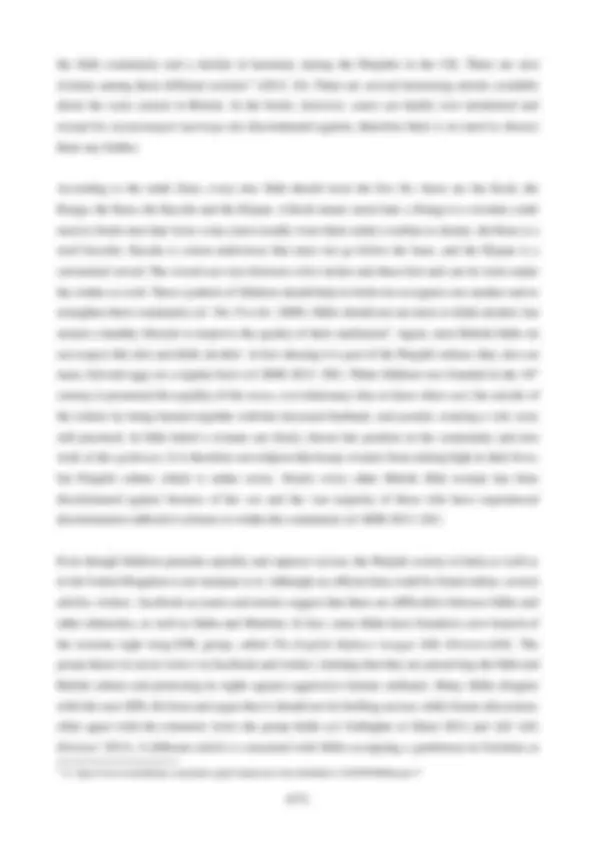
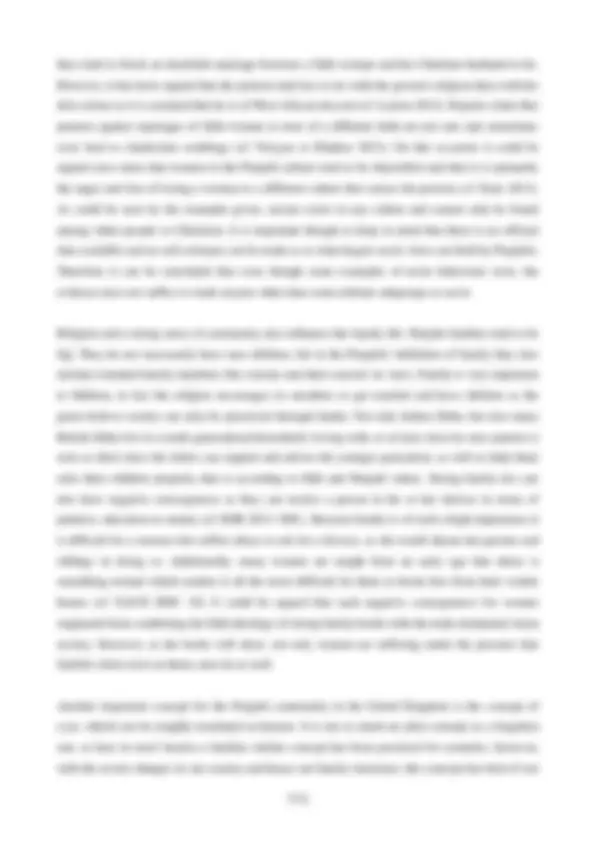
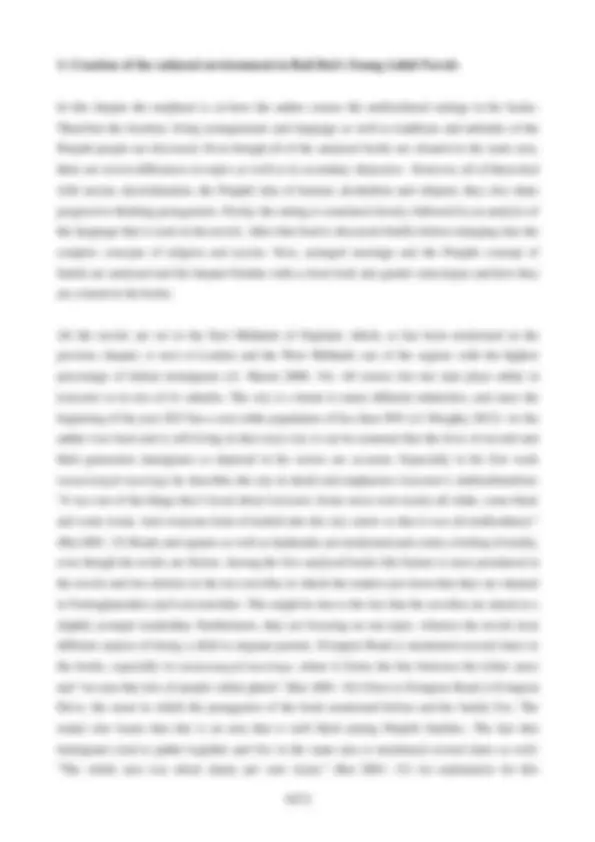
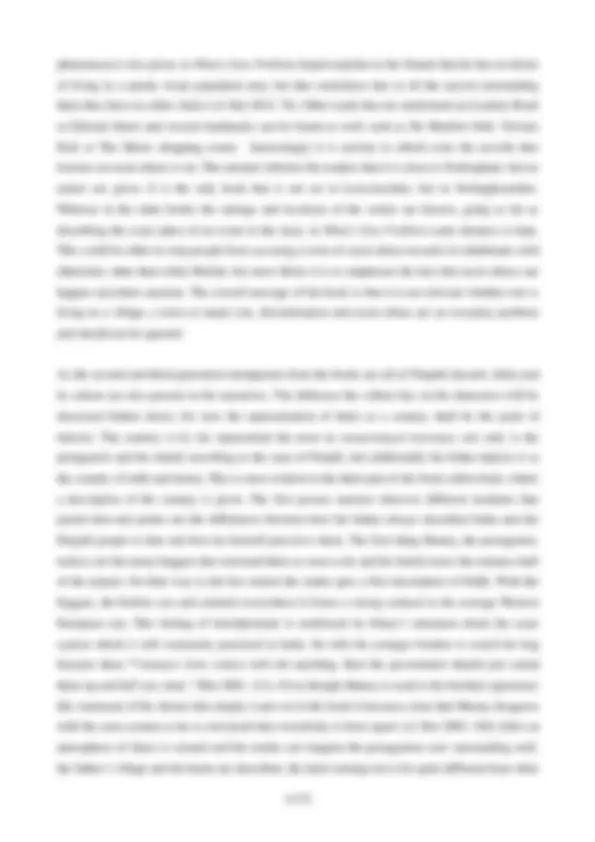
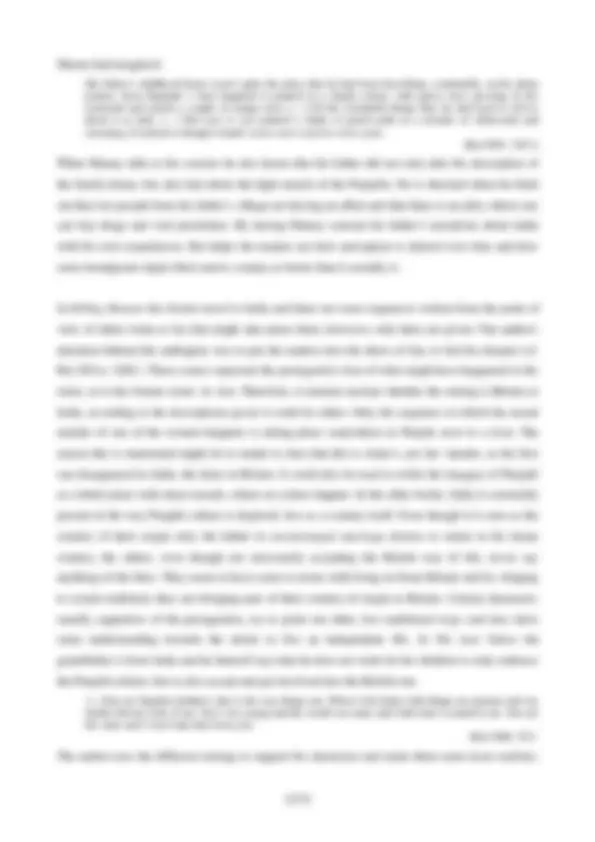
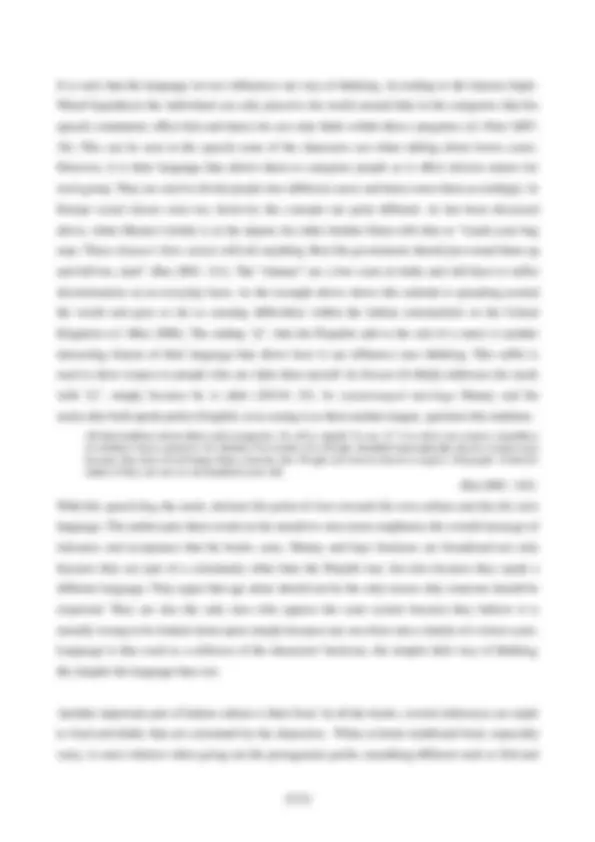
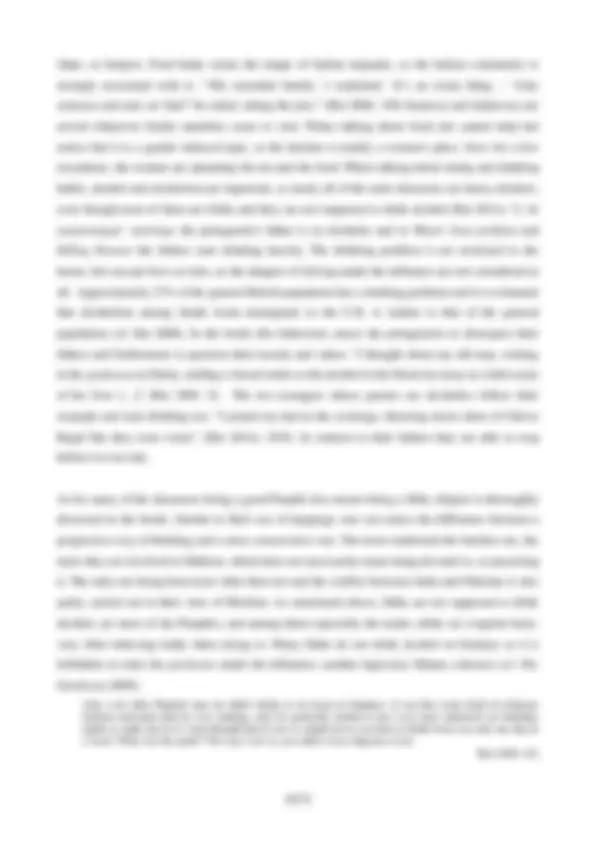
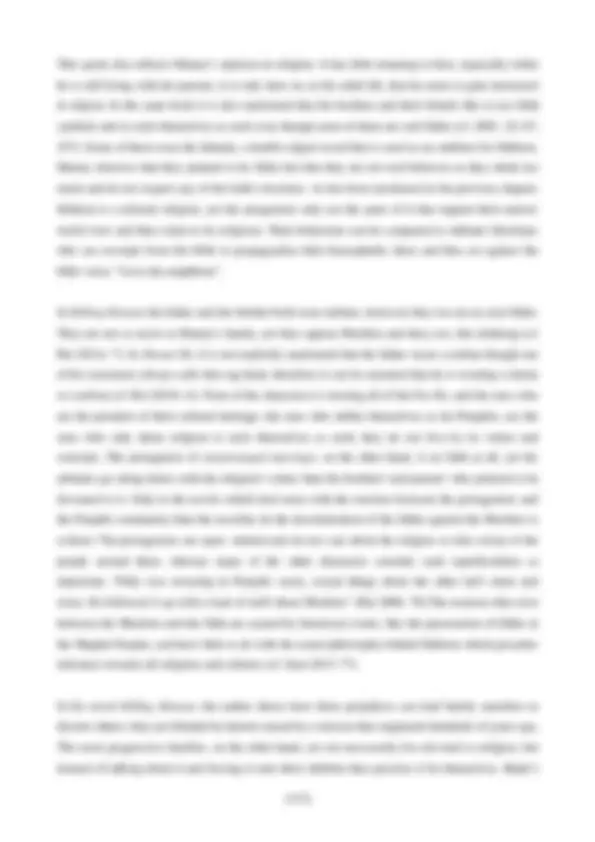
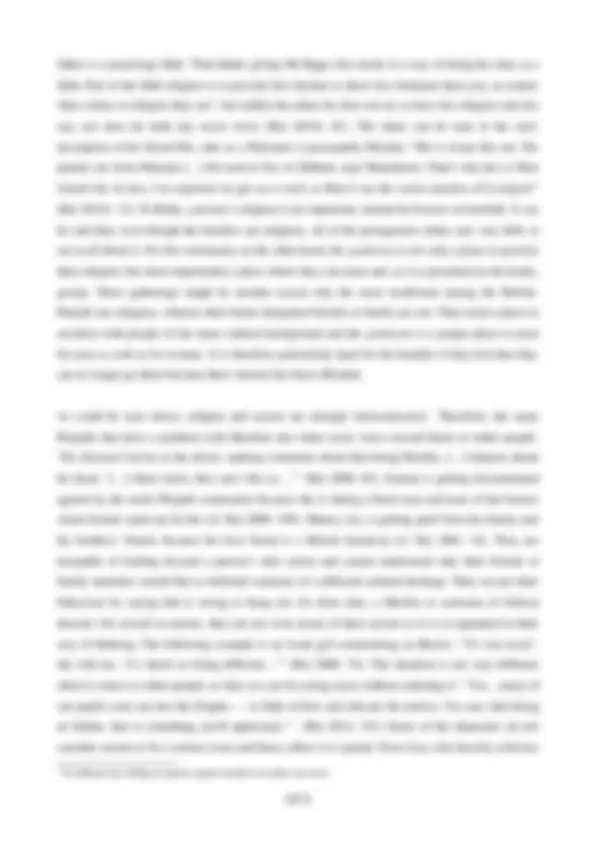
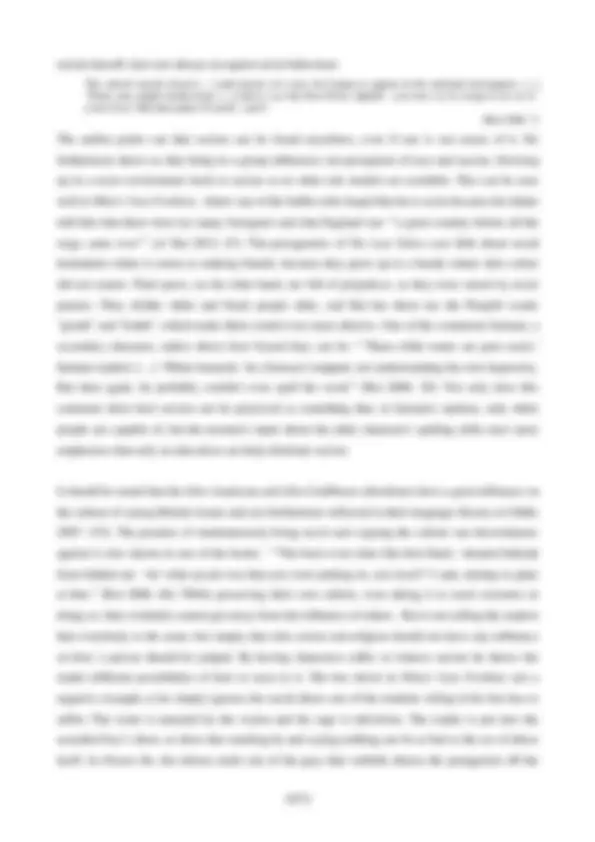
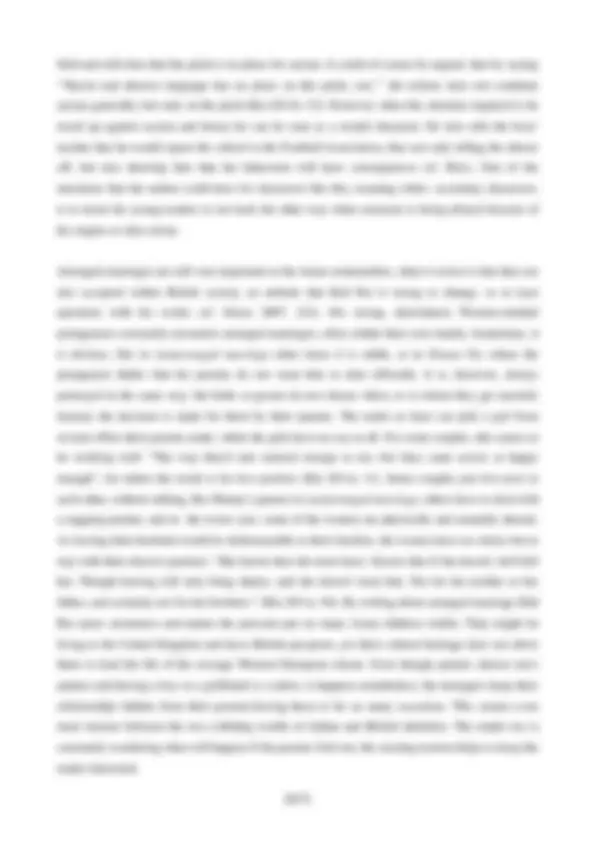
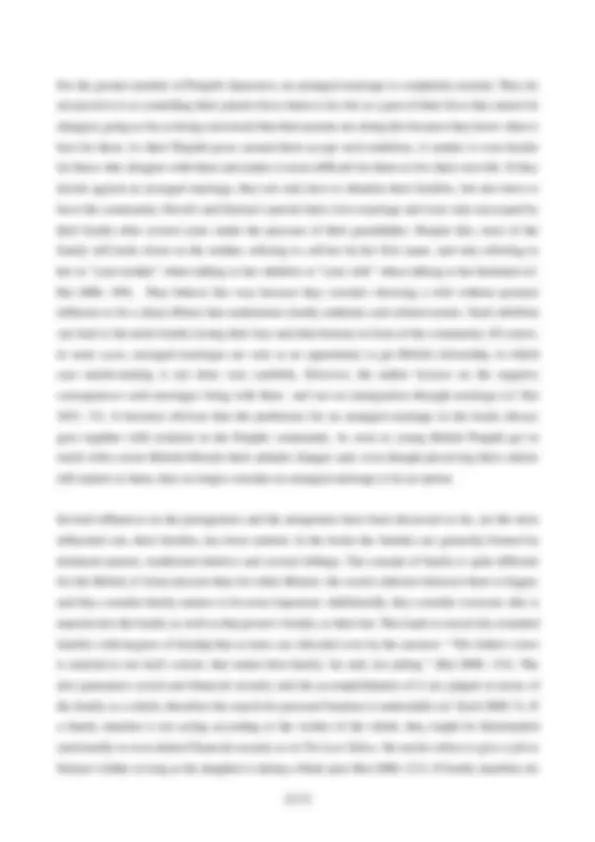
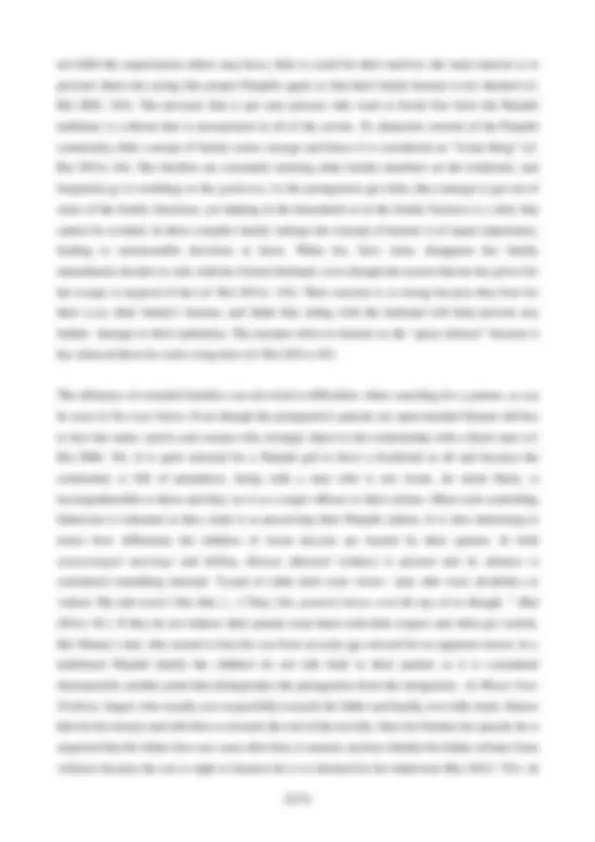
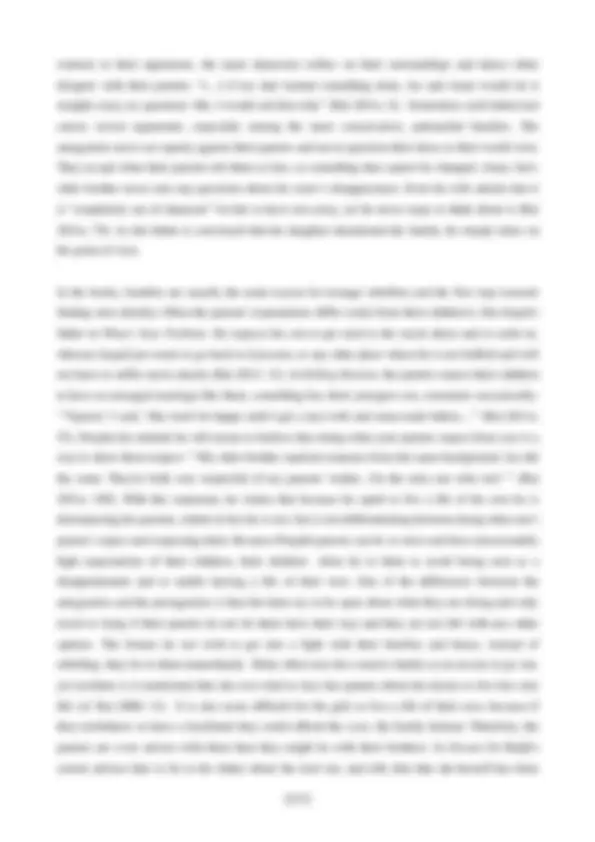
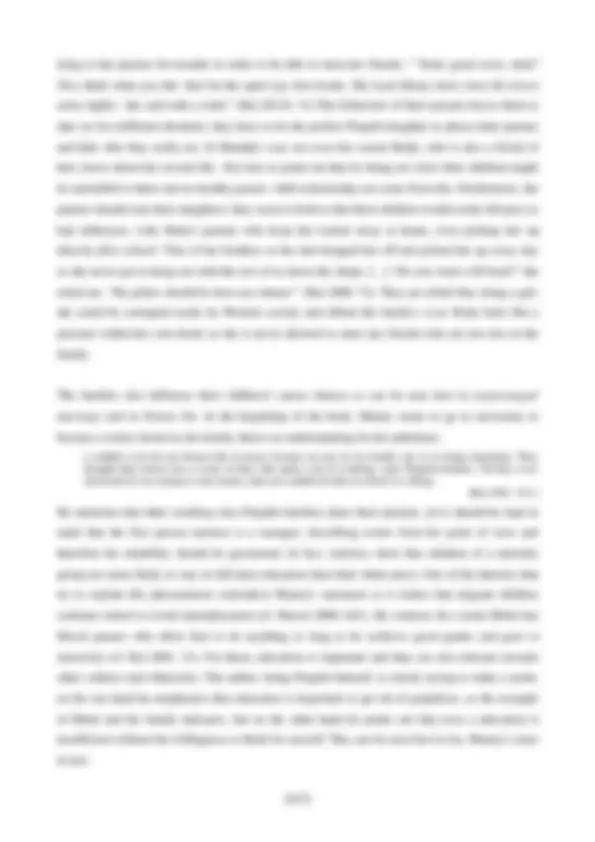
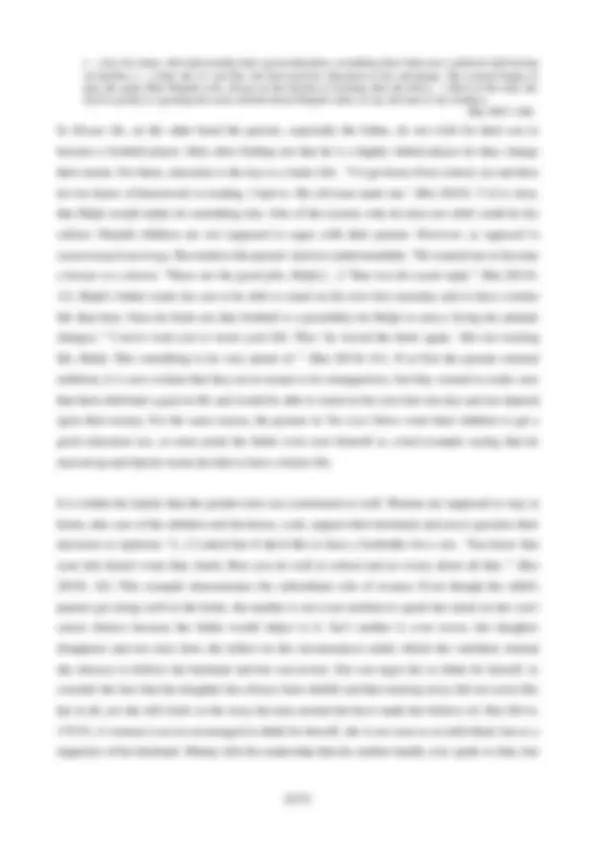
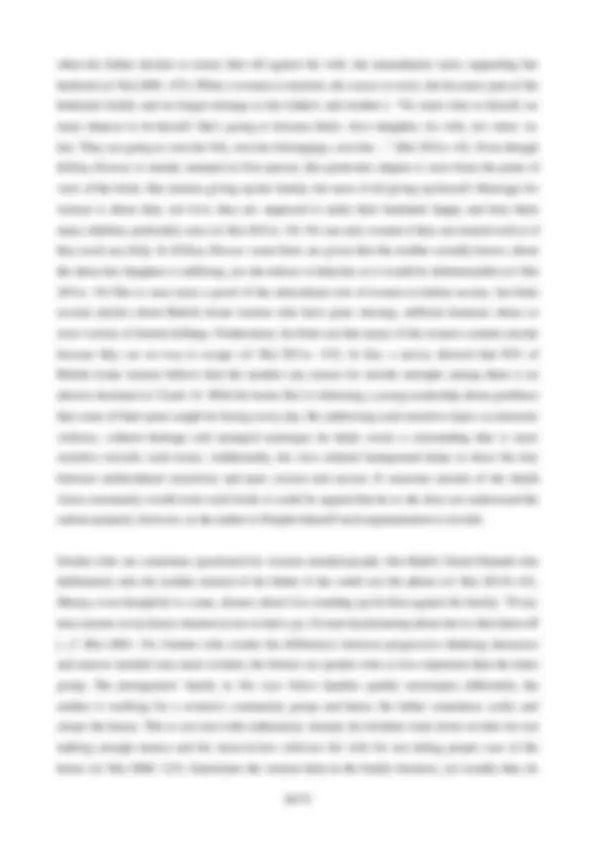
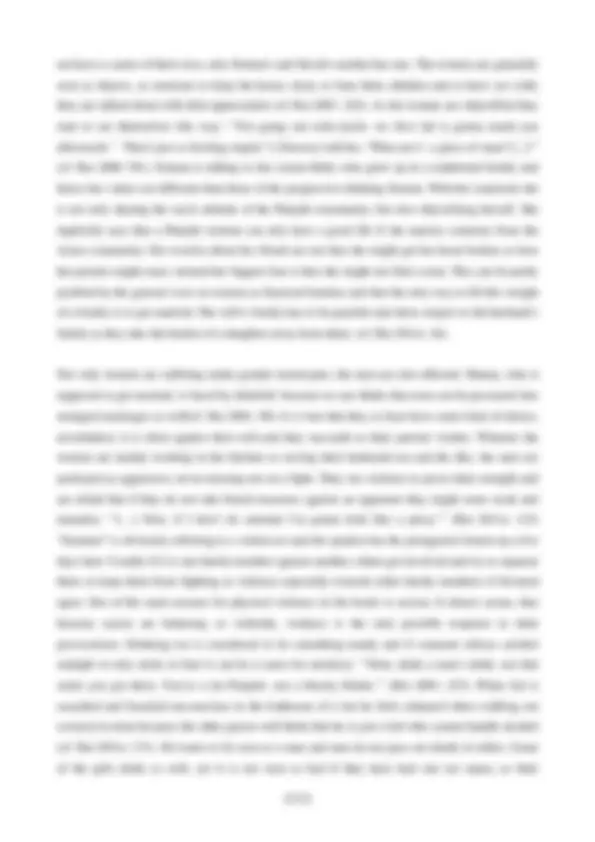
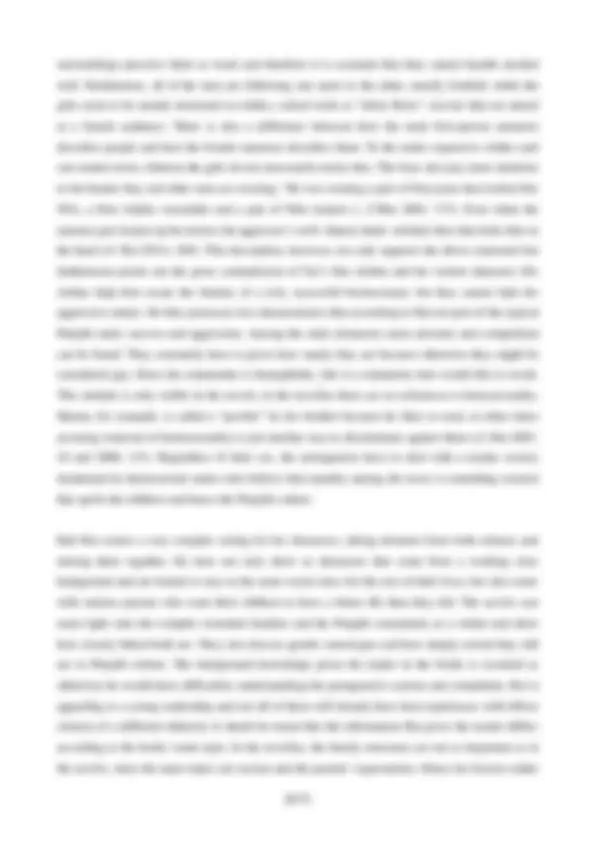

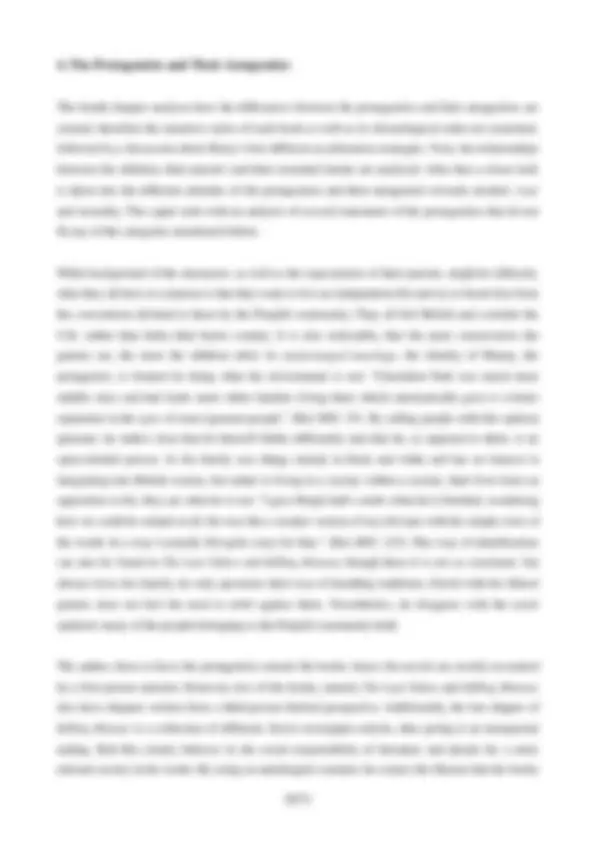
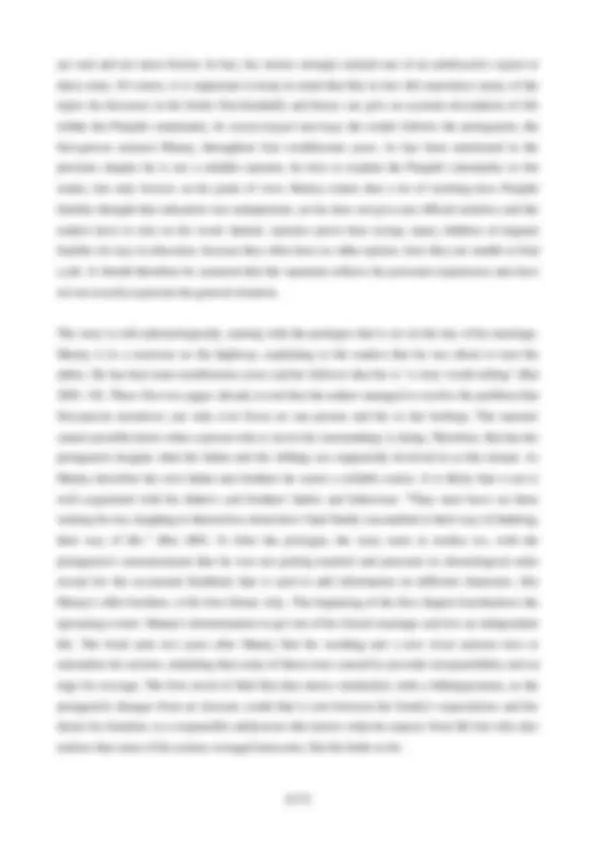

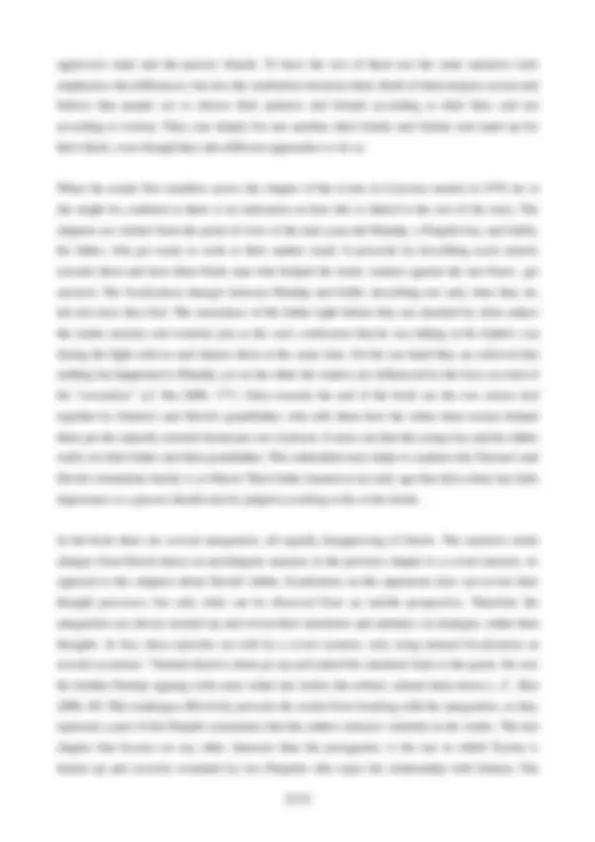
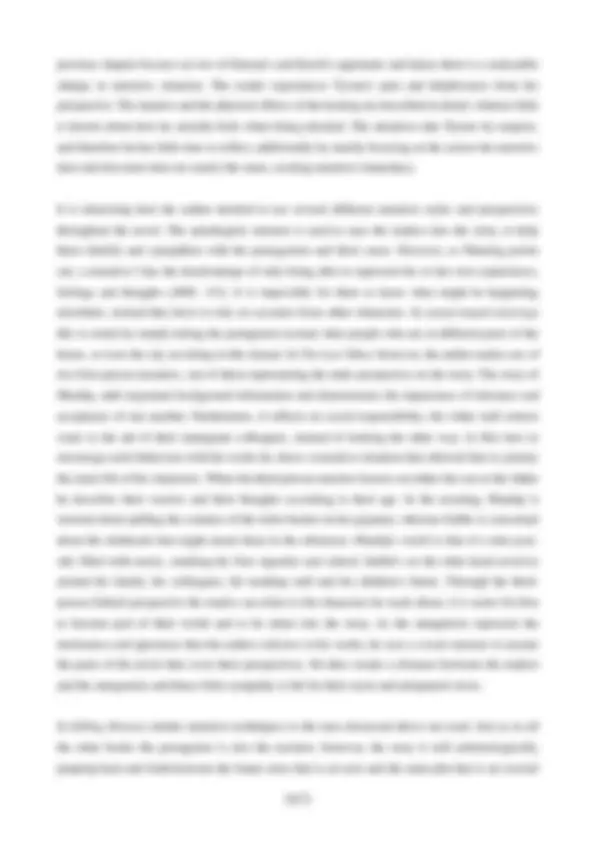
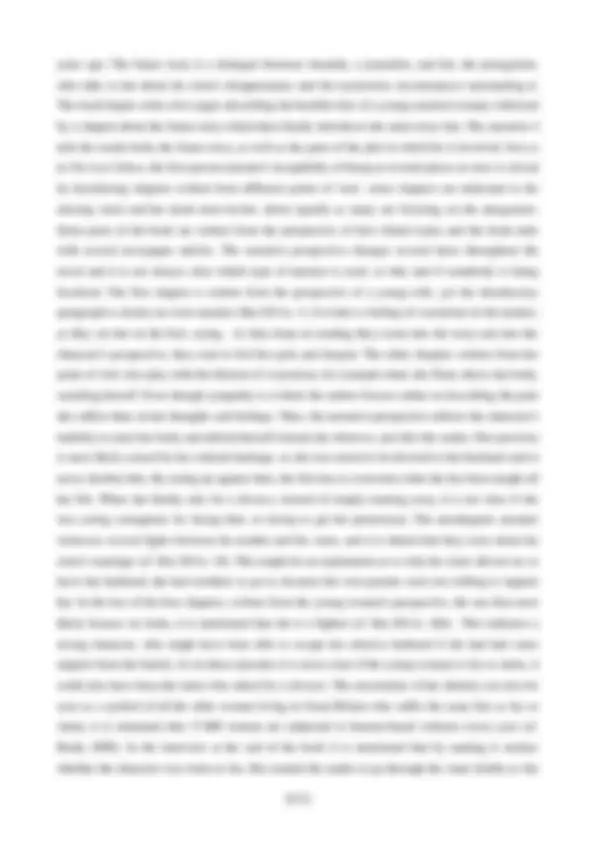

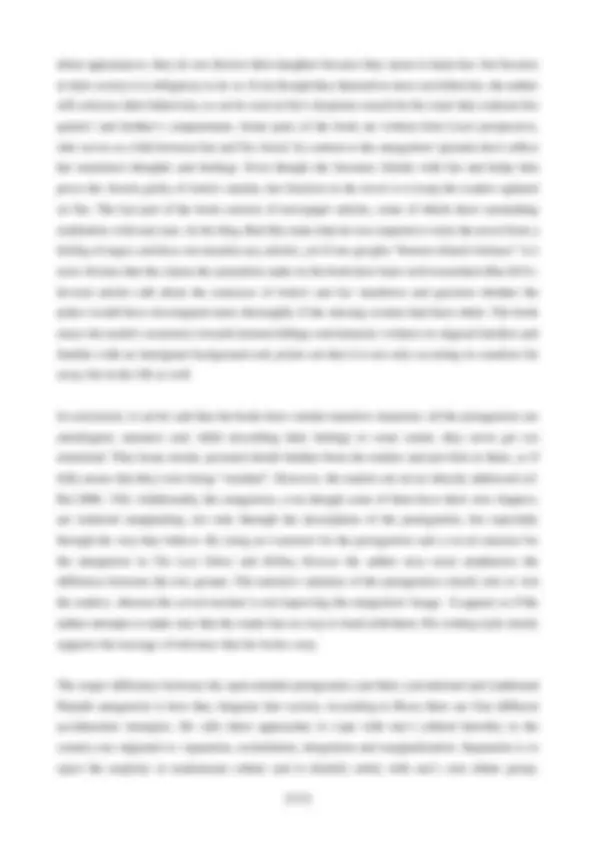
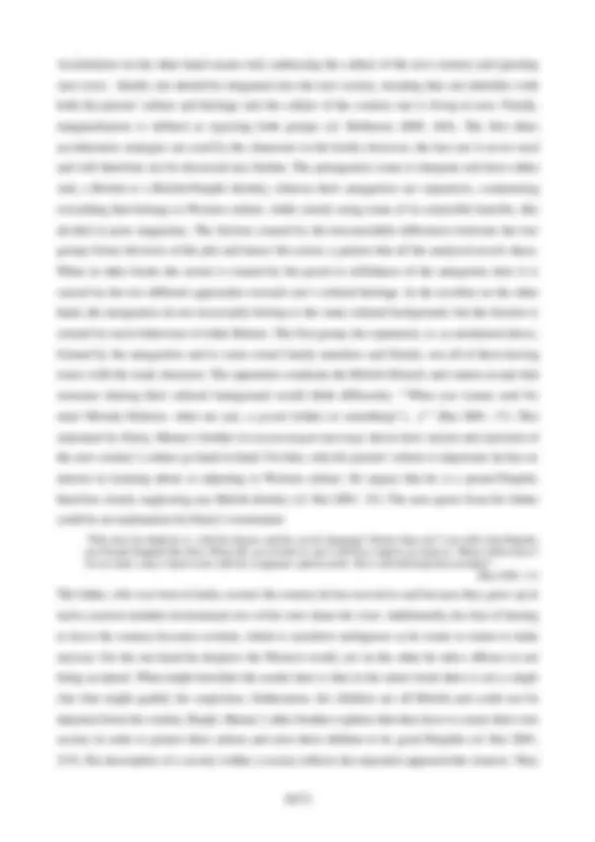
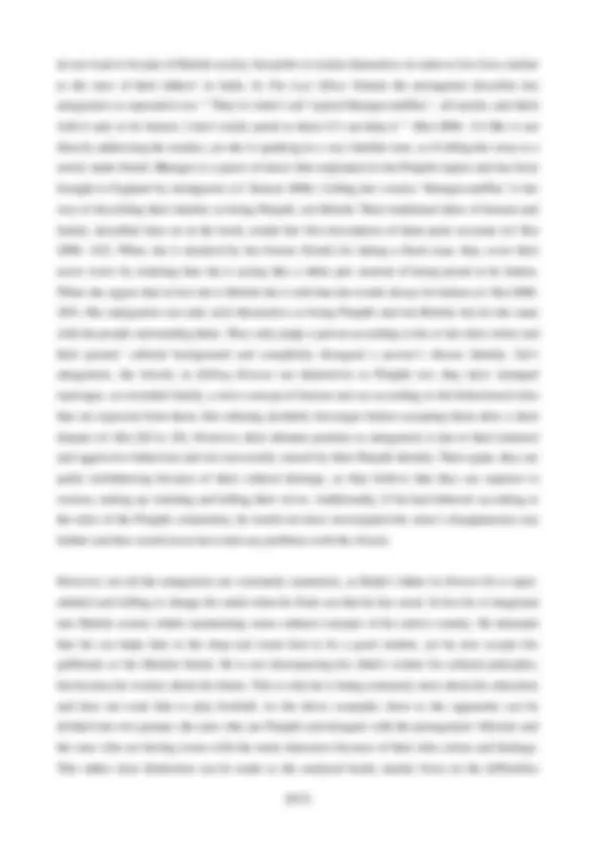
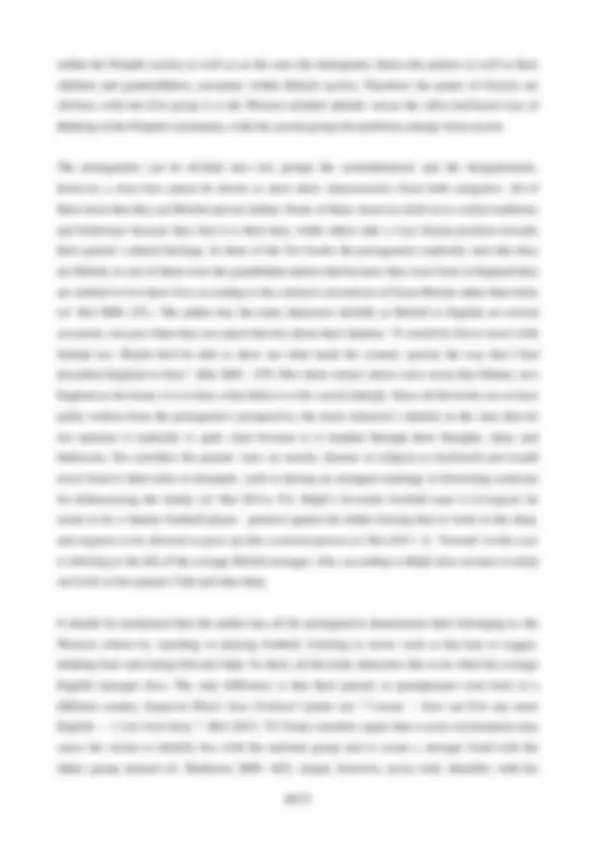
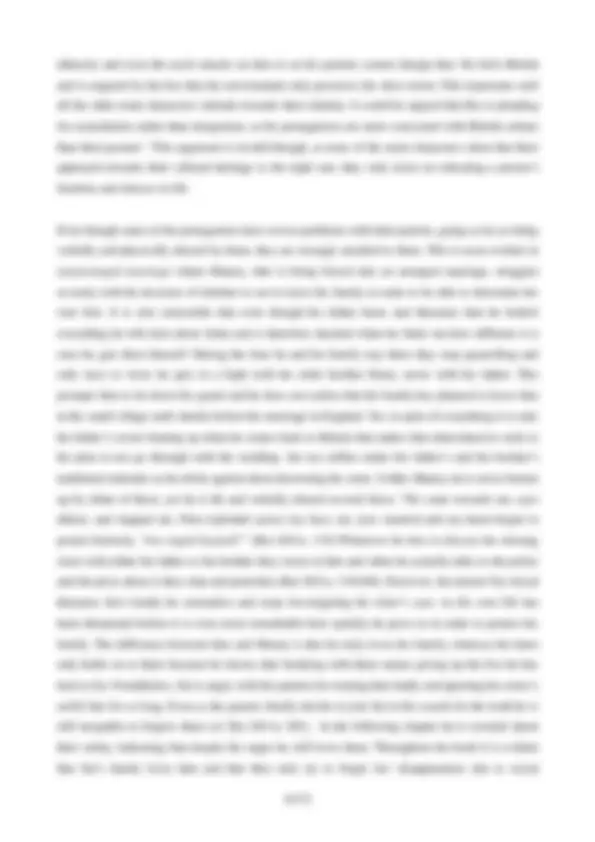
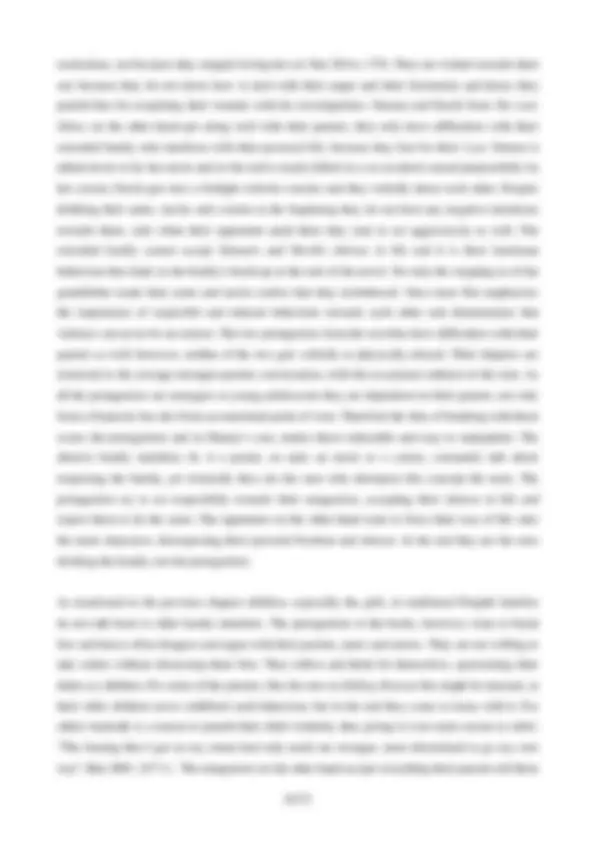
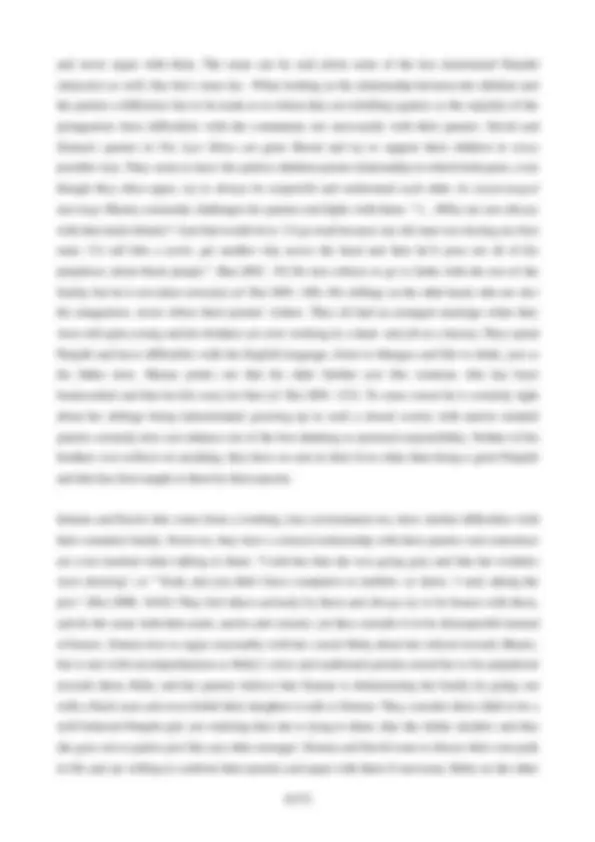
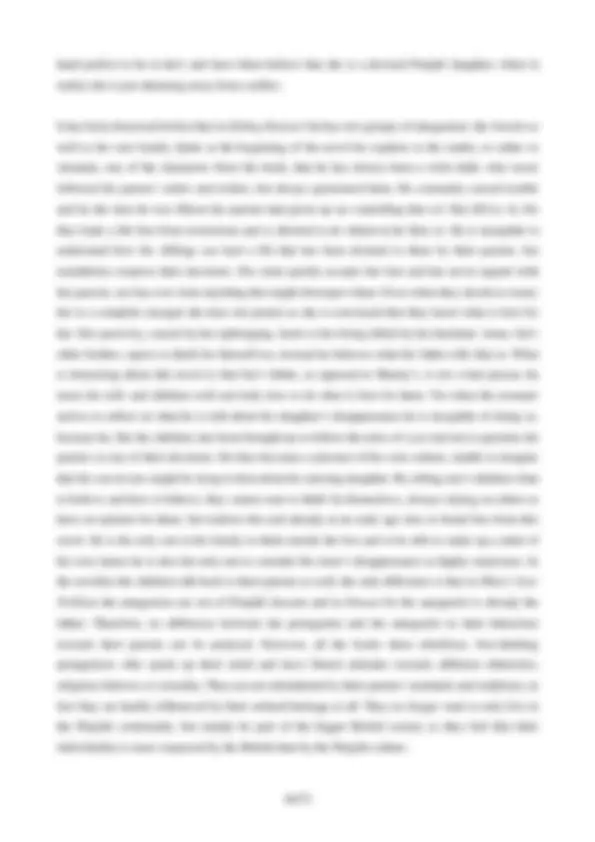
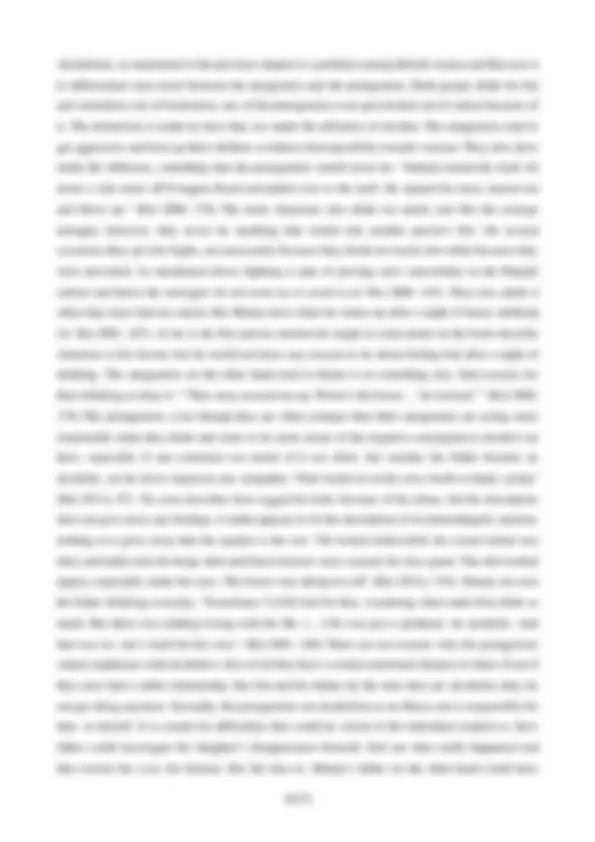
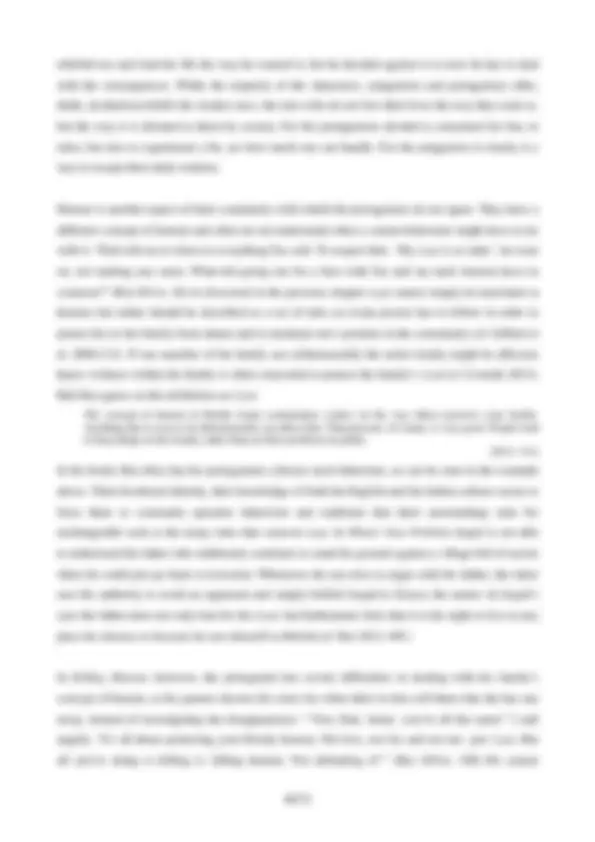
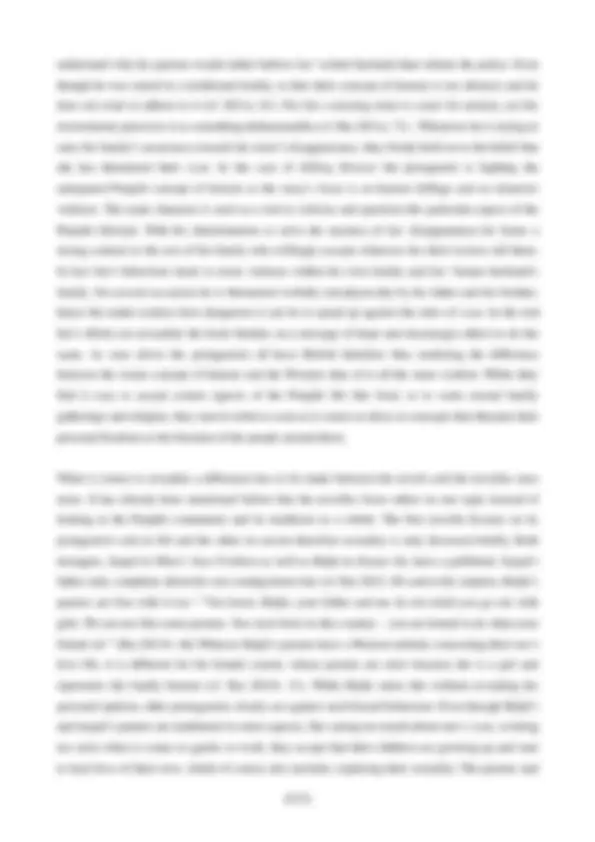
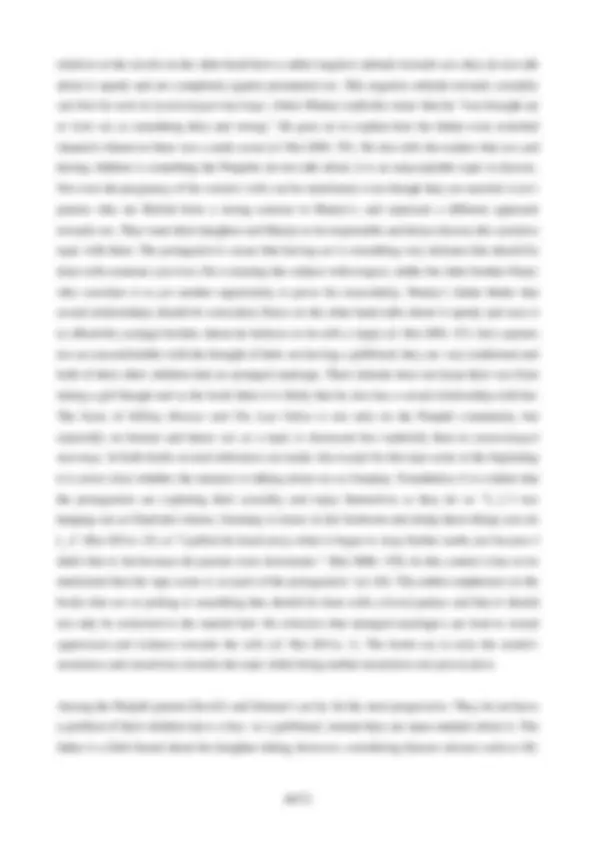
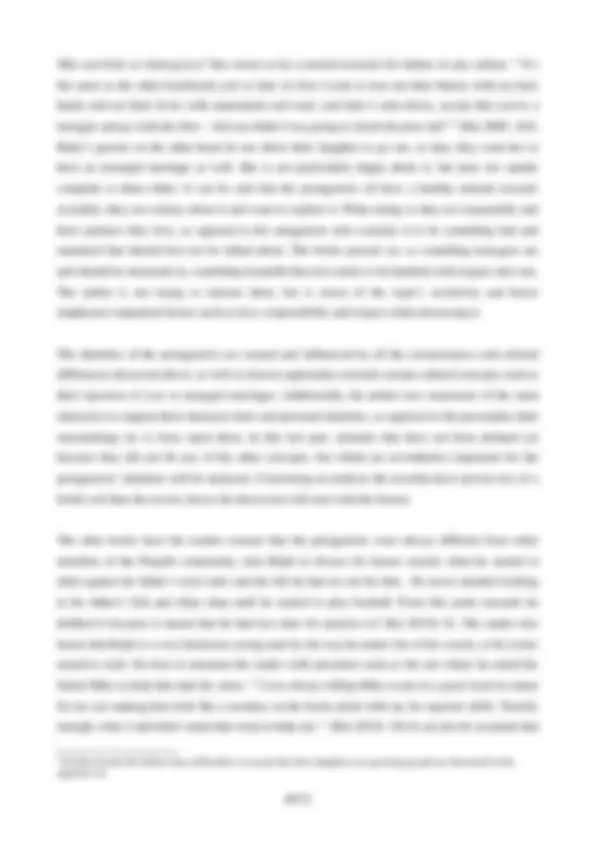
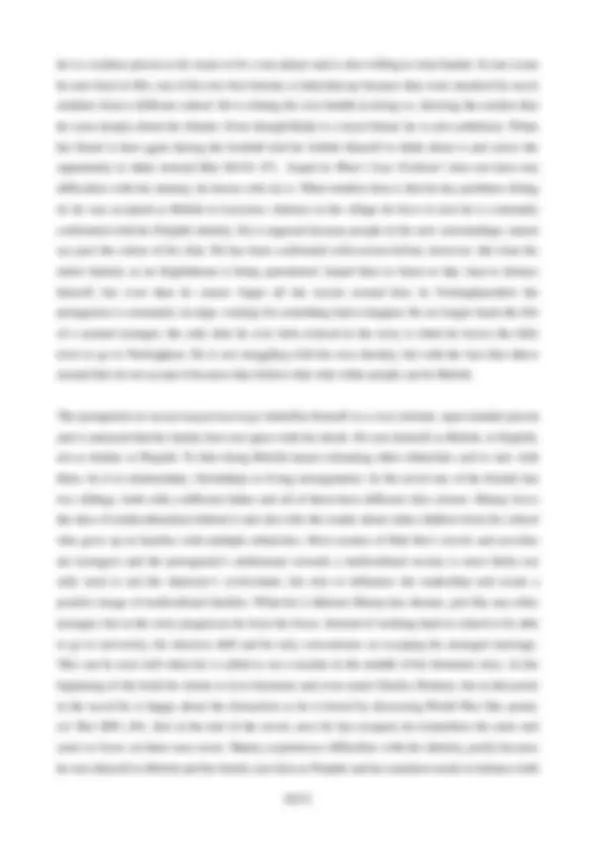
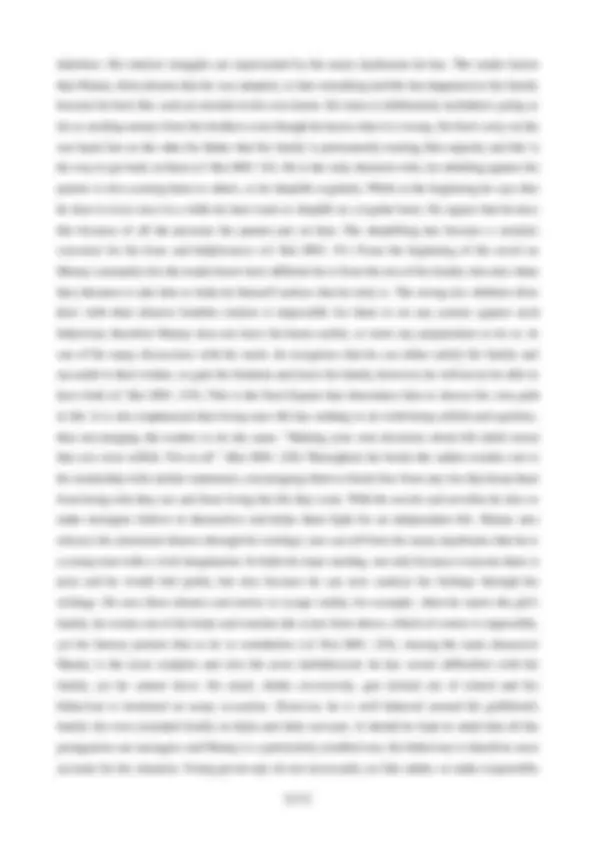
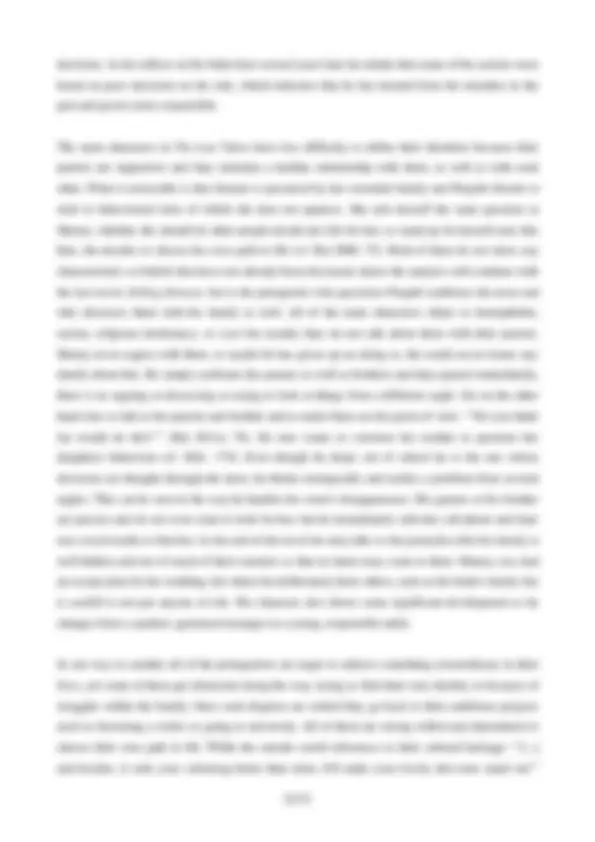

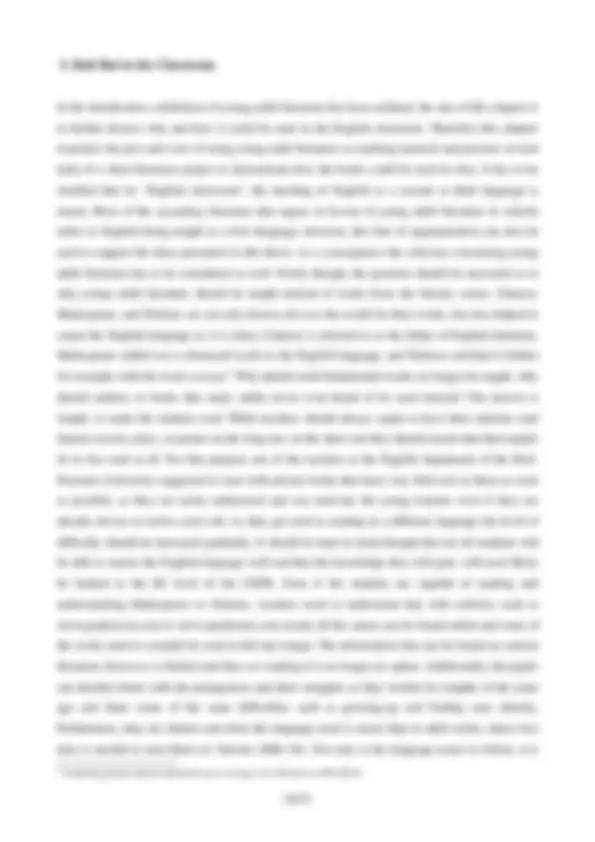
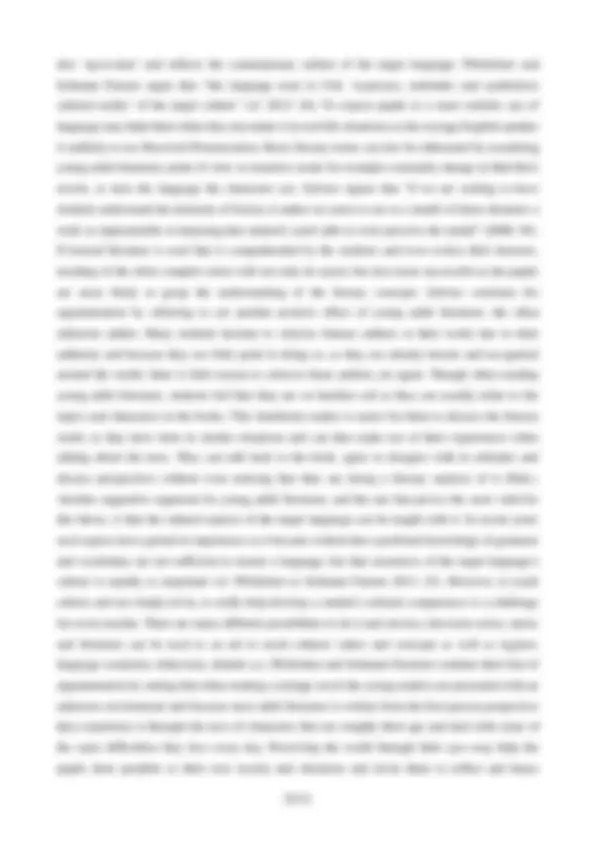
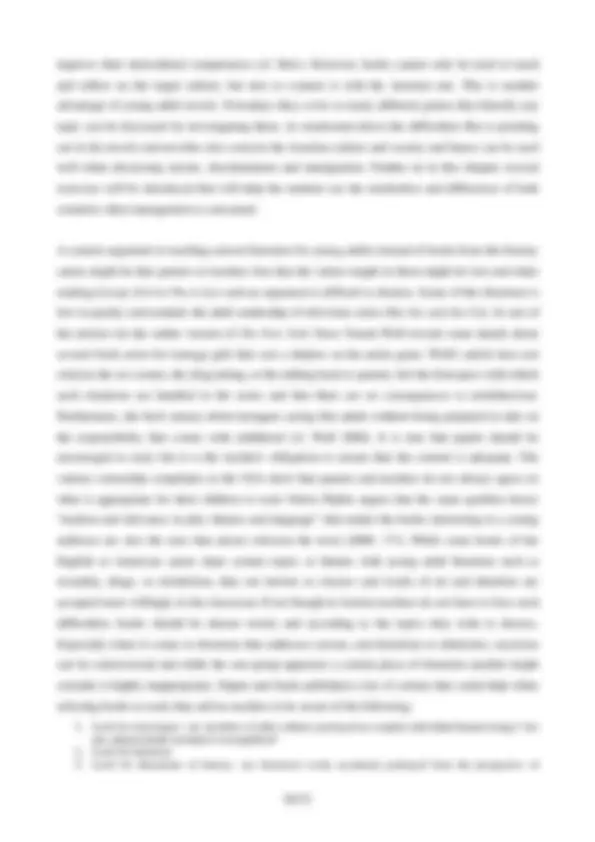
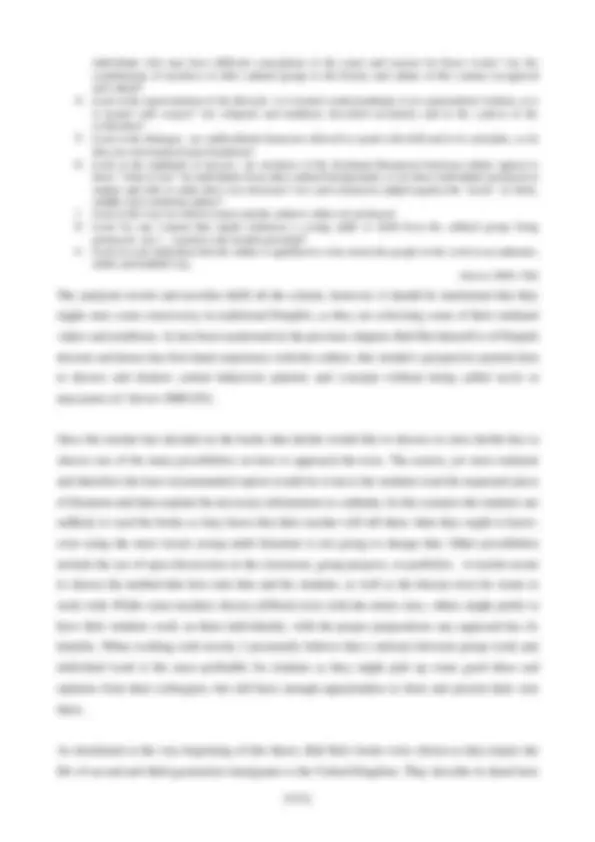
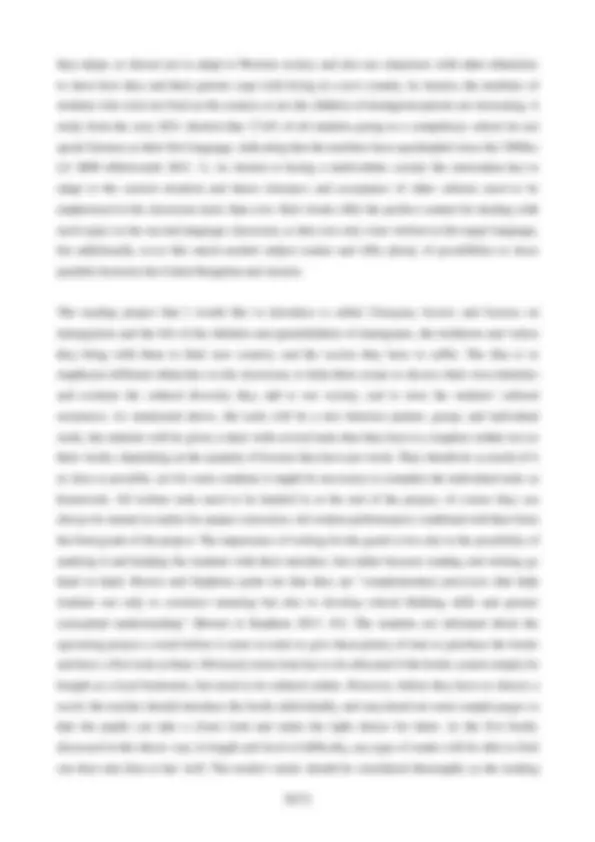
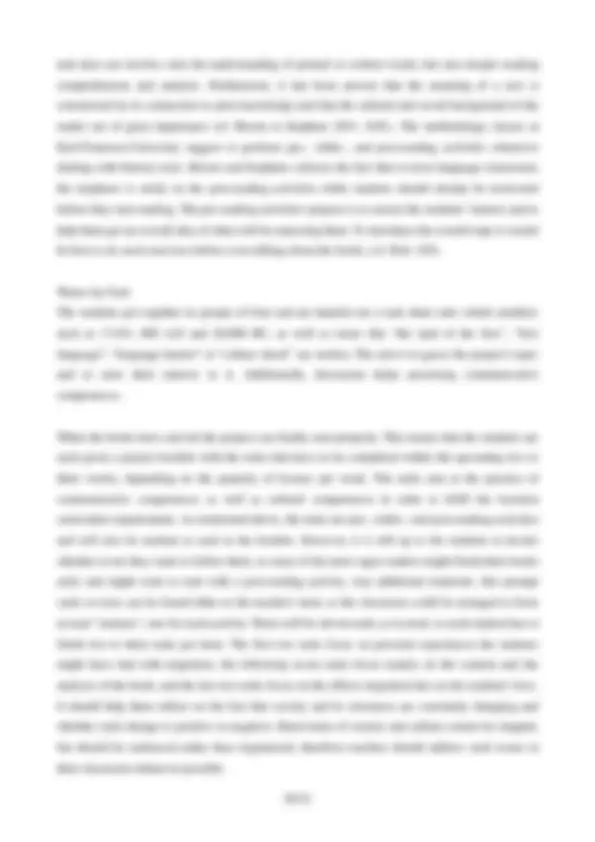
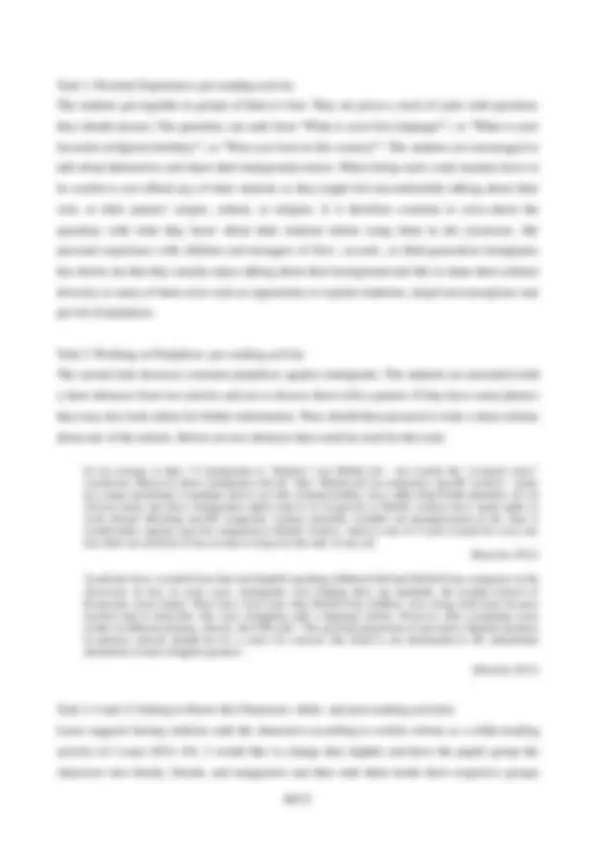
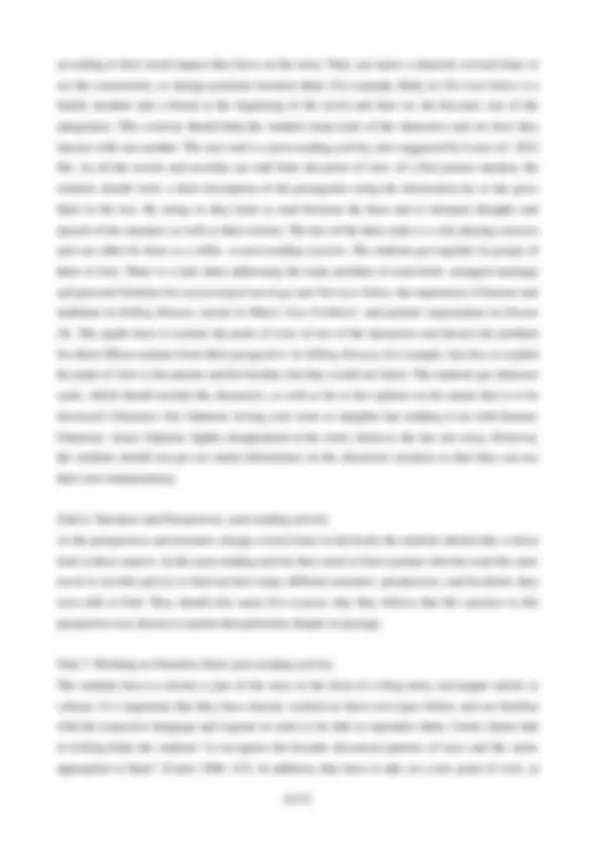
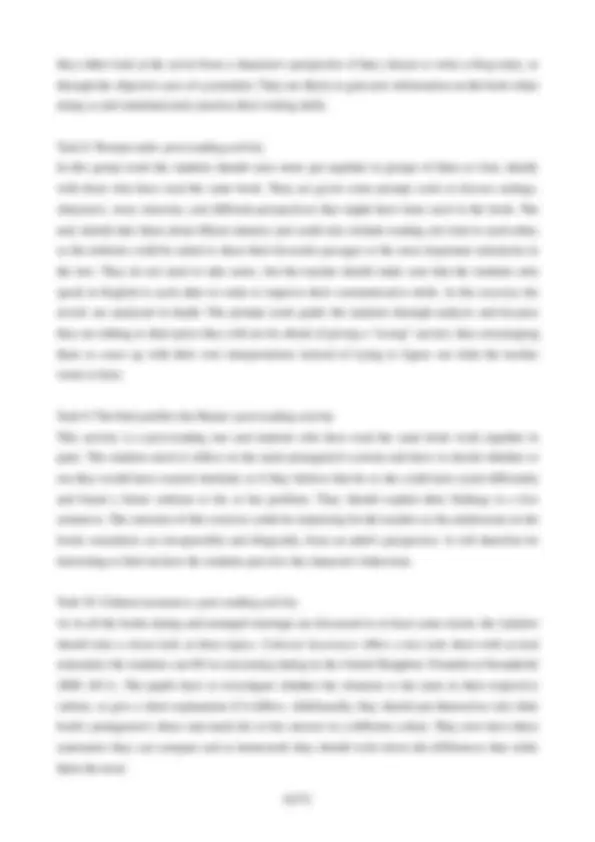
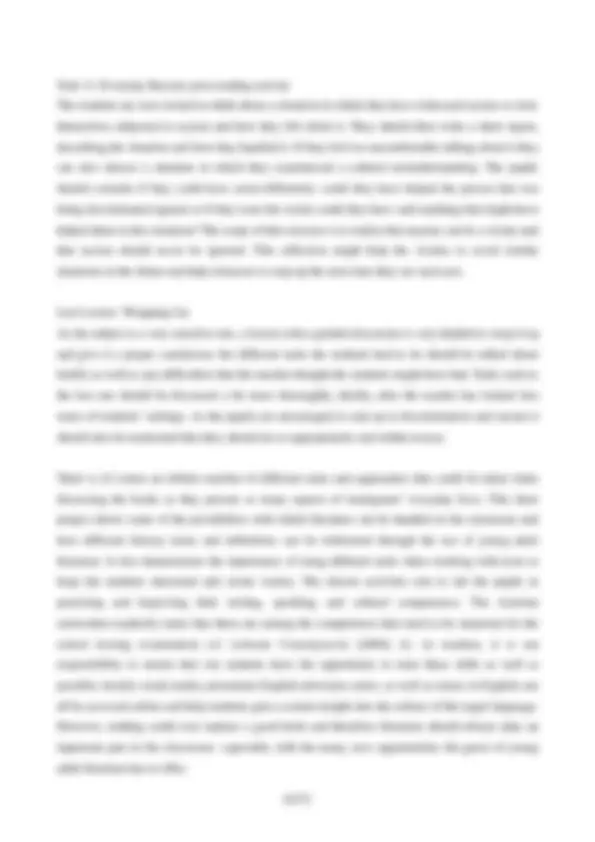
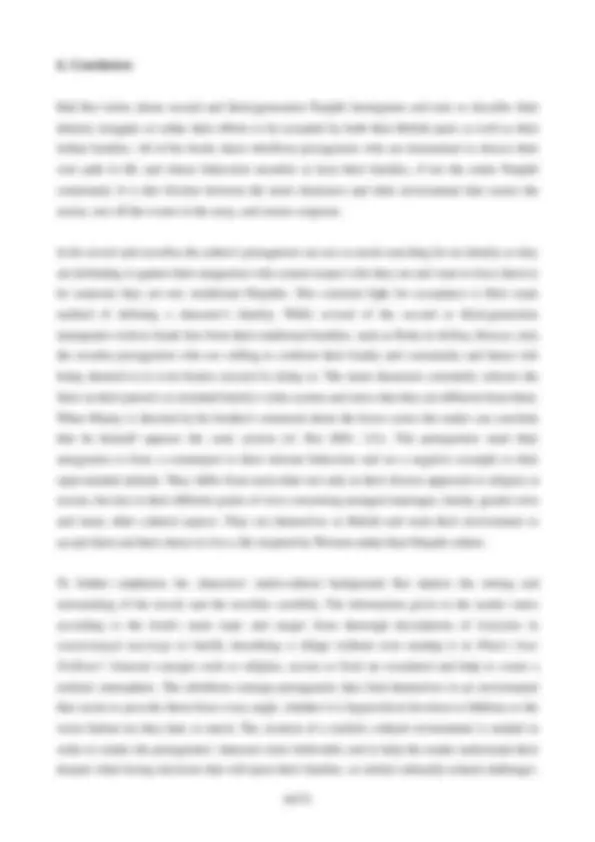

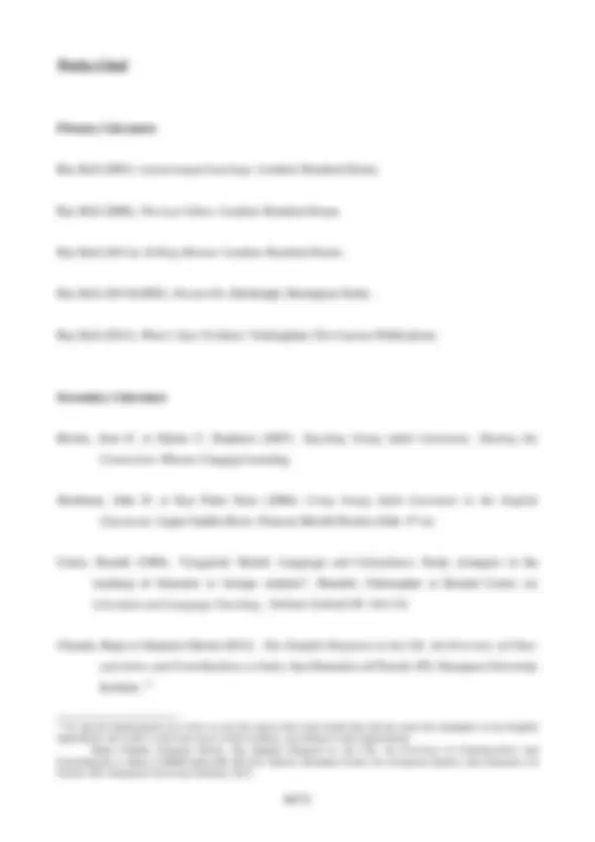

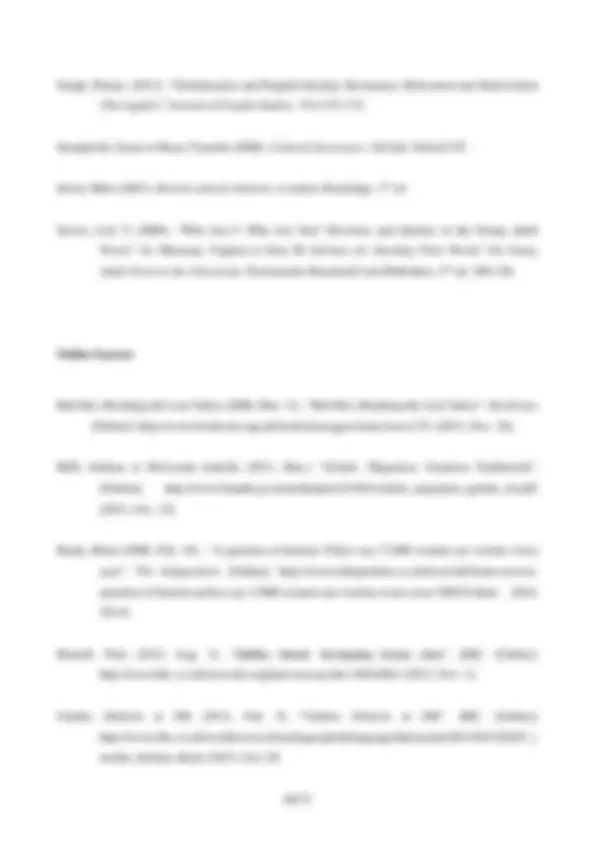
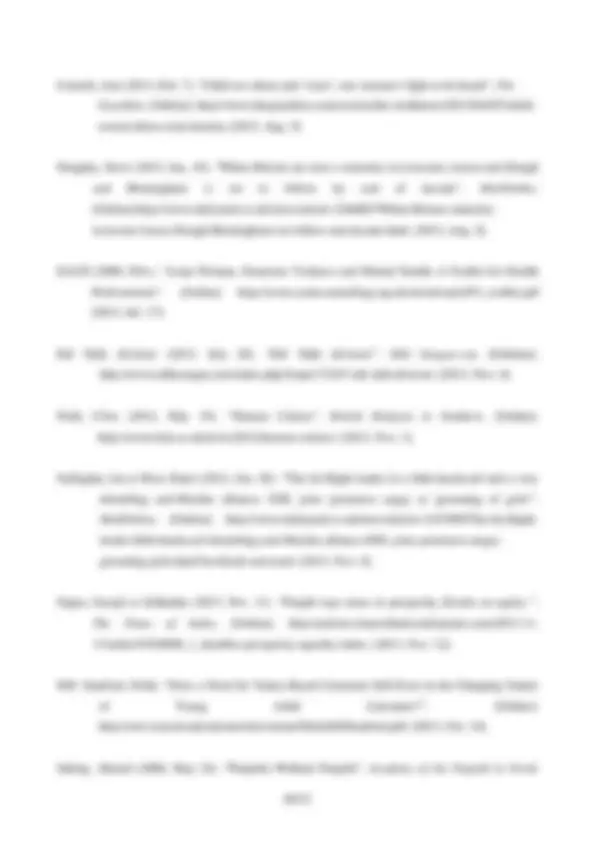

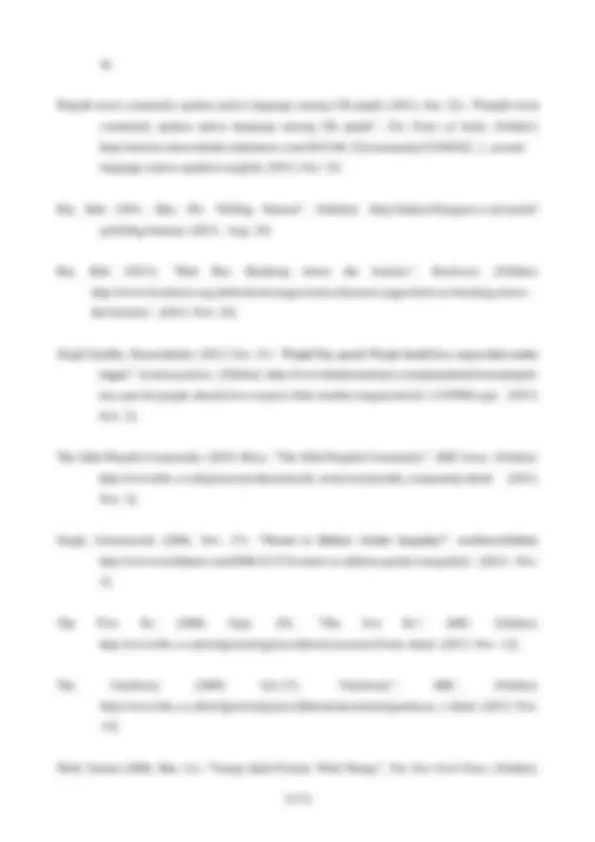



Study with the several resources on Docsity

Earn points by helping other students or get them with a premium plan


Prepare for your exams
Study with the several resources on Docsity

Earn points to download
Earn points by helping other students or get them with a premium plan
Community
Ask the community for help and clear up your study doubts
Discover the best universities in your country according to Docsity users
Free resources
Download our free guides on studying techniques, anxiety management strategies, and thesis advice from Docsity tutors
The protagonist of (un)arranged marriage, on the other hand, is no Sikh at all, yet his attitudes go along better with the religion's values than his brothers' ...
Typology: Schemes and Mind Maps
1 / 75

This page cannot be seen from the preview
Don't miss anything!




































































zur Erlangung des akademischen Grades einer Magistra der Philosophie
an der Karl-Franzens-Universität Graz
vorgelegt von Maria SUNTINGER
am Institut für Anglistik Begutachter: A.o. Univ.- Prof. Mag. Dr. phil Martin Löschnigg
Graz, 2013
As a teacher-to-be, one of the priorities of this thesis had to be its adaptability to the Austrian curriculum and since migration is a topic that can and should no longer be ignored in our schools I chose to use several of British author Bali Rai’s young adult novels. He himself is a second generation Punjabi immigrant to the United Kingdom and hence a suitable spokesman for young adults and teens who have to deal with the advantages and difficulties of their cultural heritage. He has already won several awards and two of his books were shortlisted for the Booktrust Teenage Prize. The aim of this thesis is to give an insight into how Rai portrays the troublesome worlds and identity struggles of teenagers and young adults of Indian Punjabi ethnicity. They do not only have to deal with average teenage problems such as finding a partner and getting through school, but are also confronted with families that often emphasise traditions and values that differ from the ones shared by their white peers. As it is vital for the reader to have a basic knowledge of the Punjabi culture in order to comprehend the protagonists' as well as the antagonists' actions the thesis starts with a discussion of the value system and the traditions of Punjabi culture and information about the Punjabi migration to the United Kingdom is given. It is important to notice that when using the term Punjabi this thesis is referring to the people from the state Punjab in India, not the region in Pakistan; additionally when not indicated otherwise, the term refers to the Punjabis of Sikh religion even though, there are also Muslims, Hindus and Christians living there. The actual analysis is split into two parts: the first one focuses on the cultural environment of Bali Rai's novels and novellas; these include certain cultural concepts such as honour, food or gender roles, but also basic literary concepts like setting and language. The second part looks at the way Rai creates his protagonists and their antagonists and how the differences between them are used to create suspense. Finally, in the last chapter some elements of the literary analysis are applied to create a concept for teaching the discussed novels and novellas in the Austrian classroom.
However, since the thesis focuses on young adult literature, an attempt at defining the term should be made first of all. When reading secondary literature about young adult literature one soon notices that a definition as such cannot be given easily. While some authors consider Salinger's The Catcher in the Rye (cf. Lubar 2003:19) to be the first young adult novel, others argue that the genre has always existed and that it simply has not been recognised as such. They regard Huckleberry Finn or Great Expectations to be works of young adult literature, as they tell tales of two boys growing up and struggling with their identities (cf. Hill- Stanford 2013). It could be argued that the style of these books does not necessarily appeal to the mind of a young readership, yet it should be pointed out that the one thing the majority of literature for young adults has in common is the first-
person narrator, just like Pip in Great Expectations (cf. Pölzleitner et Schumm Fauster 2013: 26). Gary M. Salver on the other hand suggests not reading Great Expectations in the classroom at all, but to discuss a similar, modern book instead (cf. 2000: 87). Even if most authors and teachers do not agree on when the phenomenon of young adult literature started, they at least concur up to a certain point on the characteristics it shares. Bushman and Parks Haas narrow them down to the following: “conflicts are often consistent with the young adult's experience, themes are of interest to young people, protagonists and most characters are young adults, and the language parallels that of young people” (2006: 2). While this definition is certainly a rather open one it at least covers all the many thematic and experimental possibilities that the young adult novel has expanded to over the past decades. When once they were used to merely lecture the reader, they can now be found in any genre and dealing with any topic. While fantasy is covered by such books as Harry Potter or The Hunger Games , a Native American teenager is trying to break out of his miserable life in the semi- autobiographical novel The Absolutely True Diary of a Part-Time Indian, and Liesel fights for survival in Germany during World War II and shares a special relationship with Death in the highly praised historical fantasy novel The Book Thief. The range of literature for young adults spans from critically well received works to less demanding ones, which also implies that it has the capability to satisfy any kind of reader. Instead of insisting on reading the classics, it is this diversity that teachers should recognise and exploit shamelessly in order to get their students to read, as the joy of reading simpler works could just spark enough interest for literature: some day they might decide to read Dickens, Eyre and Wilde after all.
to the African Continent, as well as other Asian countries and South America. The causes for migration started to change and where no longer triggered by economic necessities only, but also by relationships with immigrants, especially from British East Africa, resulting in the arrival of more Punjabis in that area. In the 1960s and 1970s Africanisation policies of these countries made it necessary for the Punjabis to leave and find a new home yet again. The majority of these refugees decided to make Britain their new home, thus being part of the secondary migration to the United Kingdom. A wave of direct migration arrived at roughly the same time, in the 1950s and 1960s; it can be assumed that the grandparents in some of the novels were part of it. The main reason for migration to Britain was the hope to build a better life for them and their families, as many of the possibilities such as educational facilities that the United Kingdom offered the Punjabis were unavailable to them in India. What started as yet another migration movement of young males soon included families and spouses as they followed the workers to their new home country (cf. Chanda et Ghosh 2012: 4f.). This theme is also picked up in the novel (un)arranged marriage as Manny’s father wants to force his son to marry a friend’s daughter in order to get her a permit to remain in the United Kingdom. There are of course still Punjabis migrating to Britain today, yet not as many as fifty years ago, as the state has become more prosperous and is now among the richest in India (cf. Gupta et. Sidhartha 2013). It is difficult to find any official data as to where in the United Kingdom the Punjabis decided to settle as no difference between Indians and Punjabis is made in the 2001 Census. However, looking at the data provided, Indian communities can be found in the North West, the North West Midlands, the East Midlands, London, London East and the South East. In fact, in some of the constituencies of the named regions they are the majority, rather than the minority. On the other hand few Indians seem to be living in Northern Ireland, Wales and Scotland, as none of the constituencies there has a majority of Indians. Taking a look at the statistics on religious beliefs it can be noticed that all the areas in which Sikhism is practised also depict an Indian majority. It could therefore be argued that these are the areas in which the Punjabis tend to live, as the Punjabi culture is closely linked to Sikhism. These constituencies would be Midlands West, Birmingham West, Coventry and North Warwickshire, London and London South East. However Dorling argues that the numbers representing religious believes are difficult to be interpreted as many chose to leave the question blank, answered 'no religion' or are part of a religion that is too low in numbers to be represented demographically (cf. 2005: 51ff.). Given that most Sikhs are Punjabi and that most Punjabis are proud Sikhs, the above assumption should not be dismissed easily as is is likely that Punjabi communities are to be found in the constituencies mentioned above (cf. The Sikh Punjabi Community 2010)
As all the protagonists and their families are Sikh, references made to a Punjabi identity in this
thesis always refer to Sikh Punjabis living in Great Britain. Yet what does it mean to be a Sikh Punjabi? What cultural values and traditions do they share and which ones did they bring to the United Kingdom with them? Other than skin colour, people are likely to recognise a migrant or a foreigner by the language they speak. Punjabi is spoken by 104 million people; it is thus the tenth most spoken language worldwide^2. In Britain it is the most common language spoken by those who do not speak English as their mother tongue (cf. Punjabi most commonly spoken native language among UK pupils 2012). In the novels all the protagonists speak it as well, though some better than others. It is an important means of identification and some of the characters even go as far as refusing to learn proper English because they are afraid of losing touch with their Punjabi heritage if they do so. However, even though Punjabi is among the most spoken languages in the world, according to an UNESCO report it is threatened to become extinct within the next 50 years. Ahmed Ishtiaq laments that the use of English and Hindi threatens the language in the Punjabi state (cf. Ishtiaq 2008) while Nirmal Singh, a Punjabi doctor and writer, claims that the language is more used and appreciated among Punjabis living abroad than among those living in India (cf. Singh Sandhu 2013). Indeed, the need for migrated Punjabis to stay in touch with their cultural heritage might cause them to hold onto to their parents’ or grandparents’ language more dearly.
Language of course is not the only element to set the Punjabi immigrants apart from others; their value system is quite different from the Western European one as well. As has been mentioned above, the creation of a common Punjabi identity never succeeded. Instead, three different types a Muslim, a Hindu and a Sikh Punjabi one can be found; the latter one is in the focus of this thesis. Sikhism preaches equality of all people regardless of sex, age, race, caste or even religion^3 , yet reality is somewhat different. For example the caste system has partly been transformed to the United Kingdom as can be seen by Dalit Solidarity Network’s proposal in 2006 to acknowledge castes and that they should be recognized as discrimination under the Single Equality Act (cf. Dhanda 2009: 57). The British Sikh Report 2013 states that even though only 3% of the British Sikhs consider caste as important 30% still identify with one and of those 69% are Jatt (cf. 2013: 19). This caste, though spelled differently, is also mentioned in some of Rai’s works: they are the land owners and higher up in the caste hierarchy. Even though Sikhism officially opposes the caste system and is a peaceful religion, the caste issue is harming the coherence of the Punjabi communities in the United Kingdom. Chanda and Ghosh say that “this has resulted in the breaking up of religious organizations and the establishment of different gurdwaras^4 for different sections of
(^2) cf. http://www.lmp.ucla.edu/Profile.aspx?LangID=95&menu= (^3) cf. http://www.sikhismguide.org/ (^4) A gurdwara can be definded as “the place where Sikhs come together for congregational worship” ( The Gurdwara 2009).
they tried to block an interfaith marriage between a Sikh woman and her Christian husband-to-be. However, it has been argued that the protests had less to do with the groom's religion than with his skin colour as it is assumed that he is of West African descent (cf. Layton 2012). Reports claim that protests against marriages of Sikh women to men of a different faith are not rare and sometimes even lead to clandestine weddings (cf. Neiyyar et Khatkar 2013). On this occasion it could be argued once more that women in the Punjabi culture tend to be objectified and that it is primarily the anger and fear of losing a woman to a different culture that causes the protests (cf. Kaur 2013). As could be seen by the examples given, racism exists in any culture and cannot only be found among white people or Christians. It is important though to keep in mind that there is no official data available and no safe estimate can be made as to what degree racist views are held by Punjabis. Therefore it can be concluded that even though some examples of racist behaviour exist, the evidence does not suffice to mark anyone other than some militant subgroups as racist
Religion and a strong sense of community also influence the family life. Punjabi families tend to be big. They do not necessarily have mor children, but in the Punjabis' definition of family they also include extended family members like cousins and their cousins' in- laws. Family is very important to Sikhism, in fact the religion encourages its members to get married and have children as the gurus believe society can only be preserved through family. Not only Indian Sikhs, but also many British Sikhs live in a multi-generational household. Living with, or at least close by ones parents is seen as ideal since the elders can support and advise the younger generation, as well as help them raise their children properly, that is according to Sikh and Punjabi values. Strong family ties can also have negative consequences as they can restrict a person in his or her choices in terms of partners, education or money (cf. BSR 2013: 30ff.). Because family is of such a high importance it is difficult for a woman who suffers abuse to ask for a divorce, as she would shame her parents and siblings in doing so. Additionally, many women are taught from an early age that abuse is something normal which renders it all the more difficult for them to break free from their violent homes (cf. EACH 2009: 10). It could be argued that such negative consequences for women originated from combining the Sikh ideology of strong family bonds with the male dominated Asian society. However, as the books will show, not only women are suffering under the pressure that families often exert on them, men do as well.
Another important concept for the Punjabi community in the United Kingdom is the concept of izzat , which can be roughly translated as honour. It is not so much an alien concept as a forgotten one: at least in rural Austria a familiar similar concept has been practised for centuries, however, with the severe changes in our society and hence our family structures, this concept has been if not
replaced at least adapted to conform to the needs of today’s society. Gilbert et al. explain that izzat represents the family’s honour and has several meanings to it, but it can be best described as a set of rules Asian family members have to respect as otherwise they would bring shame to their family (cf. 2004: 112). In the worst case family members are so worried about their izzat and what the community might think of them that they are literally willing to kill for it, as reports of honour related crimes and even honour killings sadly prove. In fact, Saima Afzal, an independent member of the Lancashire Police Authority says that it is guessed that about 10,000 honour crimes are committed each year, yet she believes that the number of victims is even higher than that (cf. Burnell 2012). According to a ComRes poll the support of honour killings among young South Asians has fallen, yet 4% of young Sikhs still believe that it can be justified in some cases. However, the vast majority of South Asian adolescents opposes the idea of violence against female members of the family, yet many of them think that they should live according to the concept of izzat (cf. Field 2012). It could be argued that to some extent Sikhism is responsible for izzat as being involved and helping in the community is one of the concepts of the religion. While a tight- knit community can be helpful when one loses one's job or happens to suffer a misfortune, breaking its rules can lead to exclusion from it. Therefore, it is important to keep up appearances so as to not lose one's status in the community. In the books several forms of izzat can be found and they are usually not related to violence. However, the author strongly criticises that female family members often have fewer liberties as they represent the family’s honour, whereas males are granted more freedom. Gender roles are also very traditional: the man is supporting the family financially, whereas the woman is taking care of the children and the household. Girls are still raised to become devoted wives and mothers, not to fulfil their dreams^6 and while there are no official numbers as to how many young women are married at an early age and leave school, bloggers and newspaper articles about violence against women reveal that the concept of equality forms a strong part of the Sikh religion is preached, but not lived (cf. Singh 2006; Kaur 2012). Gender roles are discussed, even if just marginally, in all of the analysed books, yet they do not make the Punjabis appear in a particularly bad light. In three of the books the second and third generation immigrants make it quite clear that the stereotyping will stop with them and that they feel gender roles are acceptable for their parents as the grew up with them, but they themselves are not fond or supportive of them.
From the topics discussed above it becomes clear that gender roles and religion are deeply rooted in the Punjabi community, as nearly all of the cultural concepts and traditions originated from either of the two. It is therefore surprising that studies show that the children of immigrants value their parents' religion less and do not consider it important, even though they generally are curious about (^6) cf. http://users.aber.ac.uk/asg/girls-99.htm
In this chapter the emphasis is on how the author creates the multicultural settings in his books. Therefore the location, living arrangements and language as well as traditions and attitudes of the Punjabi people are discussed. Even though all of the analysed books are situated in the same area, there are severe differences in topics as well as in secondary characters. However, all of them deal with racism, discrimination, the Punjabi idea of honour, alcoholism and religion; they also share progressive thinking protagonists. Firstly, the setting is examined closely, followed by an analysis of the language that is used in the novels. After that food is discussed briefly before emerging into the complex concepts of religion and racism. Next, arranged marriage and the Punjabi concept of family are analysed and the chapter finishes with a closer look into gender stereotypes and how they are created in the books.
All the novels are set in the East Midlands of England, which, as has been mentioned in the previous chapter, is next to London and the West Midlands one of the regions with the highest percentage of Indian immigrants (cf. Mason 2000: 34). All stories but one take place either in Leicester or in one of it's suburbs. The city is a home to many different ethnicities, and since the beginning of the year 2013 has a non-white population of less than 50% (cf. Doughty 2013). As the author was born and is still living in that exact city it can be assumed that the lives of second and third generation immigrants as depicted in his stories are accurate. Especially in his first work (un)arranged marriage he describes the city in detail and emphasises Leicester’s multiculturalism: “It was one of the things that I loved about Leicester. Some areas were nearly all white, some black and some Asian. And everyone kind of melted into the city centre so that it was all multicultural.“ (Rai 2001: 33) Roads and squares as well as landmarks are mentioned and create a feeling of reality, even though the works are fiction. Among the five analysed books this feature is most prominent in the novels and less distinct in the two novellas in which the readers just learn that they are situated in Nottinghamshire and Leicestershire. This might be due to the fact that the novellas are aimed at a slightly younger readership. Furthermore, they are focusing on one topic, whereas the novels treat different aspects of being a child to migrant parents. Evington Road is mentioned several times in the books, especially in (un)arranged marriage , where it forms the line between the richer areas and “an area that lots of people called ghetto” (Rai 2001: 34) Close to Evington Road is Evington Drive, the street in which the protagonist of the book mentioned before and his family live. The reader also learns that this is an area that is well liked among Punjabi families. The fact that immigrants tend to gather together and live in the same area is mentioned several times as well: “The whole area was about ninety per cent Asian.” (Rai 2001: 33) An explanation for this
phenomena is also given, in What’s Your Problem Jaspal explains to his friends that he has no desire of living in a purely Asian populated area, but that sometimes due to all the racism surrounding them they have no other choice (cf. Rai 2012: 76). Other roads that are mentioned are London Road or Edward Street and several landmarks can be found as well, such as De Monfort Hall, Victoria Park or The Shires shopping centre. Interestingly it is unclear in which town the novella that focuses on racist abuse is set. The narrator informs the readers that it is close to Nottingham, but no names are given. It is the only book that is not set in Leicestershire, but in Nottinghamshire. Whereas in the other books the settings and locations of the stories are known, going as far as describing the exact place of an event in the story, in What's Your Problem some distance is kept. This could be either to stop people from accusing a town of racist abuse towards its inhabitants with ethnicities other than white British, but more likely it is to emphasise the fact that racist abuse can happen anywhere anytime. The overall message of the book is that it is not relevant whether one is living in a village, a town or major city, discrimination and racist abuse are an everyday problem and should not be ignored.
As the second and third generation immigrants from the books are all of Punjabi descent, India and its culture are also present in the narratives. The influence the culture has on the characters will be discussed further down, for now the representation of India as a country shall be the point of interest. The country is by far represented the most in (un)arranged marriage ; not only is the protagonist and his family travelling to the state of Punjab, but additionally his father depicts it as the country of milk and honey. This is most evident in the third part of the book called India , where a description of the country is given. The first person narrator observes different incidents that puzzle him and points out the differences between how his father always described India and the Punjabi people to him and how he himself perceives them. The first thing Manny, the protagonist, notices are the many beggars that surround them as soon as he and his family leave the entrance hall of the airport. On their way to the bus station the reader gets a first description of Delhi. With the beggars, the broken cars and animals everywhere it forms a strong contrast to the average Western European city. This feeling of bewilderment is reinforced by Harry’s statement about the caste system which is still commonly practised in India. He tells his younger brother to watch his bag because these “‘ chamarr (low castes) will rob anything. Best the government should just round them up and kill' em, innit.’”(Rai 2001: 121). Even though Manny is used to his brothers ignorance this statement of his shocks him deeply. Later on in the book it becomes clear that Manny disagrees with the caste system as he is convinced that everybody is born equal. (cf. Rai 2001: 169) After an atmosphere of chaos is created and the reader can imagine the protagonists new surrounding well, the father’s village and his home are described, the latter turning out to be quite different from what
but also to help understand their motives. Nottinghamshire for example is full of hostility, and the feeling that something bad is bound to happen is constantly closing in on the readers. Rai manages to create a hostile atmosphere throughout the book, by gradually increasing the racist threats the protagonist and his family have to endure. If at the beginning they only suffer verbal abuse, they soon are humiliated in more violent ways, such as the dog pooh in the letter box or graffiti on their shop window. Ironically Jaspal describes their new home as “the perfect English village”, presumably referring to the cottages and the only white population (Rai 2012: 38). In (un)arranged marriage, the episode of the family trip to India helps the readers see why Manny's father, who was brought up there, is so conservative. Furthermore it puts the impossibility to stick to just one cultural identity in a new country into evidence. What might make perfect sense in one’s native culture could be inappropriate in another. The family sticking together and living in one place is important in rural areas where the labourers are needed, but not so appropriate in Britain, where it can cause feelings of claustrophobia. The negative consequences can also be seen in Manny's spoiled, overly protected nephew, who in comparison to his cousins, of the same age, seems underdeveloped. Another example would be the hostility of the Sikhs against the Muslims. Given the Indio-Pakistani conflict, the friction between those two parties in that particular area is to some degree understandable. However, living in Britain it should not be something to cling onto. The author uses this argument to describe the struggles of the second and third generation immigrants with their British identities: they embrace old concepts so much because some of them do not feel British but Punjabi. Others, on the other hand, have problems with their parents or parts of their family because they are not discriminating against Muslims, black or white people.
Except for a few sequences, the books are set in the United Kingdom, and hence geography cannot be the only link Rai uses to indicate the Punjabi roots. Another distinctive feature is the language, which as well as the location is more elaborated in the novels than in the novellas. Three types of language can be found in the books. The first group is formed by first-generation immigrants who speak English fluently, but incorrectly. One example of this particular form of English would be Baljit’s father in Dream On : “‘Today I not working. I celebrating Ranjit’s new baby boy, innit. […] That settle then.’” (Rai 2011b: 35). He does not use the present continuous or the past tense correctly, and throughout the whole book he hardly uses the verb be. In The Last Taboo , the grandfather uses more or less the same English as Baljit’s father: “‘Making me the cup tea, daughter,’ he said, in his funny English.“ (Rai 2006: 245). This rather broken English indicates that the speaker is not originally from this country, but that he or she has migrated to it. It does not, however, show how much the user identifies with the country he or she is now living in. The grandfather and Baljit’s dad both do not speak the language well, yet they both feel comfortable
with British culture and want to be part of it, whereas Manny’s father, whose English is better, refuses to participate in Western culture. He belongs to the second group, which is generally formed by the second or third-generation immigrants. They use a sociolect marked by a wrong use of grammar, the usage of Punjabi words and ending phrases with “innit”, a replacement of the negative tag question. In order to make the working class background of the families more visible, the author has them use harsh language on various occasions, something that contrasts strongly with the better educated characters who use proper English: “’Dem tings is like footballs,‘ laughed Raji” (Rai 2006: 227). He is one of the racist characters and his way of talking describes his intellect. Sociolect shows the unwillingness of the speakers to integrate and to be involved in British culture. Rai also has other characters use English sociolects, like the English that is spoken by the Jamaican community. The difference is that they can adapt their language accordingly, sometimes switching from one sociolect to another. The author uses language to describe a character's openness towards the world around him as well as to show the culture with which they identify. There are some exceptions, for example Jas, who has received a good education, but still has a very traditional way of thinking, or Sat's parents, who speak proper English, but have strict ideas about their honour. The latter ones, however, are to some extent willing to integrate into British culture and also have some Western ideas: they are opposed to hitting one's children and also allow their youngest son to live a very liberal life. The members of the third group belong to the second and third generation as well, yet they speak colloquial English, like it is spoken by their non-Asian peers: “‘I ain't got no money, though,’ I told him. ‘I'm gonna have to nick some out of one of my brothers' wallets.’” (Rai 2001: 83). Among the analysed books the language feature is the most prominent in (un)arranged marriage and in The Last Taboo. In these books, the protagonists have to struggle against their families and communities to live the life they want for themselves, while their antagonists are solely identifying themselves as Punjabi and not as British. The language groups render the differences between the protagonists and the antagonists even more evident. In What's Your Problem Jaspal's father speaks with a heavy accent and clearly belongs to the first group, the mother apparently is unable to speak any English at all. Jaspal on the other hand is part of the third group, as he was born and raised in Britain. As the story is set in a village where there are only white people no examples of the second group are given; the same applies to Dream On because the protagonist sees himself as British rather than Punjabi, and therefore only uses the language that is spoken by the third group. The three language groups do not only show us three different ways of speaking, but are also a medium through which the author expresses the speakers identity and whether he or she feels Punjabi or British. It can be said that the second group is used by those characters who have been born in Britain, but who feel Indian, or rather Punjabi, whereas the third group is used by those who feel British, rather than Punjabi.
chips, or burgers. Food helps create the image of Indian migrants, as the Indian community is strongly associated with it: “‘My extended family,’ I explained. ‘It’s an Asian thing…’ ‘Like samosas and saris an’ that?’ he asked, taking the piss.” (Rai 2006: 150) Samosas and Indian tea are served whenever family members come to visit. When talking about food one cannot help but notice that it is a gender induced topic, as the kitchen is mainly a woman's place. Save for a few exceptions, the women are preparing the tea and the food. When talking about eating and drinking habits, alcohol and alcoholism are important, as nearly all of the male characters are heavy drinkers, even though most of them are Sikhs and they are not supposed to drink alcohol (Rai 2011a: 7). In (un)arranged marriage the protagonist's father is an alcoholic and in What's Your problem and Killing Honour the fathers start drinking heavily. The drinking problem is not restricted to the house, but can put lives at risks, as the dangers of driving under the influence are not considered at all. Approximately 27% of the general British population has a drinking problem and it is estimated that alcoholism among South Asian immigrants to the U.K. is similar to that of the general population (cf. Rai 2006). In the books this behaviour causes the protagonists to disrespect their fathers and furthermore to question their morals and values. “I thought about my old man, waiting in the gurdwara in Derby, smiling a forced smile as the alcohol in his blood ate away at a little more of his liver […]” (Rai 2001: 9). The two teenagers whose parents are alcoholics follow their example and start drinking too: “I joined my dad in the evenings, throwing down shots of Chivas Regal like they were water.” (Rai 2011a: 183f). In contrast to their fathers they are able to stop before it is too late.
As for many of the characters being a good Punjabi also means being a Sikh, religion is thoroughly discussed in the books. Similar to Rai's use of language, one can notice the difference between a progressive way of thinking and a more conservative one. The more traditional the families are, the more they are involved in Sikhism, which does not necessarily mean being devoted to, or practising it. The rules are being bent more often than not and the conflict between India and Pakistan is also partly carried out in their view of Muslims. As mentioned above, Sikhs are not supposed to drink alcohol, yet most of the Punjabis, and among them especially the males, drink on a regular basis, very often behaving badly when doing so. Many Sikhs do not drink alcohol on Sundays as it is forbidden to enter the gurdwara under the influence; another hypocrisy Manny criticises (cf. The Gurdwara 2009): Like a lot other Punjabi men, he didn’t drink or eat meat on Sundays. It was like some kind of religious fashion statement that he was making, only he generally tended to get even more plastered on Saturday nights to make up for it. I just thought that it was so stupid not to eat meat or drink booze on only one day in a week. What was the point? The way I saw it, you either were religious or not. Rai (2001: 63)
This quote also reflects Manny’s opinion on religion. It has little meaning to him, especially while he is still living with his parents; it is only later on, in his adult life, that he starts to gain interested in relgion. In the same book it is also mentioned that his brothers and their friends like to use Sikh symbols and to style themselves as such even though none of them are real Sikhs (cf. 2001: 25; 87; 257). Some of them wear the khanda, a double edged sword that is used as an emblem for Sikhism. Manny observes that they pretend to be Sikh, but that they are not real believers as they drink too much and do not respect any of the faith's doctrines. As has been mentioned in the previous chapter, Sikhism is a tolerant religion, yet the antagonists only use the parts of it that support their narrow world view and then claim to be religious. Their behaviour can be compared to militant Christians who use excerpts from the bible to propagandise their homophobic ideas and thus act against the bible verse: “Love thy neighbour”.
In Killing Honour the father and the brother both wear turbans; however they too are no real Sikhs. They are not as racist as Manny's family, yet they oppose Muslims and they, too, like drinking (cf. Rai 2011a: 7). In Dream On, it is not explicitly mentioned that the father wears a turban though one of his customers always calls him rag head, therefore it can be assumed that he is wearing a dastar or a turban (cf. Rai 2011b: 6). None of the characters is wearing all of the five Ks, and the ones who are the proudest of their cultural heritage, the ones who define themselves as Jat Punjabis, are the ones who only abuse religion to style themselves as such; they do not live by its values and concepts. The protagonist of (un)arranged marriage , on the other hand, is no Sikh at all, yet his attitudes go along better with the religion's values than his brothers' and parents' who pretend to be devouted to it. Only in the novels which deal more with the tensions between the protagonists and the Punjabi community than the novellas do the discrimination of the Sikhs against the Muslims is evident. The protagonists are open- minded and do not care about the religion or skin colour of the people around them, whereas many of the other characters consider such superficialities as important: “Pally was swearing in Punjabi- nasty, sexual things about the other lad’s mum and sister. He followed it up with a load of stuff about Muslims” (Rai 2006: 70).The tensions that exist between the Muslims and the Sikh are caused by historical events, like the persecution of Sikhs in the Mughal Empire, and have little to do with the actual philosophy behind Sikhism which preaches tolerance towards all religions and cultures (cf. Sian 2013: 77).
In his novel Killing Honour, the author shows how these prejudices can lead family members to disown others; they are blinded by hatred caused by a tension that originated hundreds of years ago. The more progressive families, on the other hand, are not necessarily less devoted to religion, but instead of talking about it and forcing it onto their children they practise it for themselves. Baljit’s